
Management Audit Committee
|
Table of Contents |
|
|
|
Chapter 1: Background and Description |
|
Chapter 2: One-Page Descriptions of the 26 LDIs Chapter 3: Funds Allocated to LDIs Earn Less-Than-Market Returns |
|
Chapter 4: Unobligated LDI Funds Also Earn Less-Than-Market Returns |
|
Chapter 5: LDIs Should Complement Other State Efforts to Accomplish the Same Public Purposes |
|
Chapter 6: A More Formal Process Could Enhance Legislative Oversight for LDIs |
Executive Summary
Chapter 1: Background
This report was produced in response to a request by the Joint Revenue Interim Committee that the Management Audit Committee review some 26 legislatively designated programs and projects, or "LDIs." Several issues of concern to the Revenue Committee were that the statutory authorizations for these investments now exceed $1.1 billion, yet only about half of the funds authorized are actively being used by the specific programs and projects. In addition, many LDIs have existed for years without a review of their performance or a determination of whether they are still needed.
We found that the Legislature has designated approximately $1.1 billion, or one-third of the state's $3.25 in investable funds, for LDI purposes. The largest source of this funding is the Permanent Wyoming Mineral Trust Fund (PWMTF), although the Permanent Land Fund and operating funds are also used. Many of these investments receive below-market rates of return, and some involve more risk than the State Treasurer's other allowable investments. A listing of LDIs can be found later in this report.
Individually and collectively, LDIs are a version of economically targeted investing, whose aim it is to improve the economic well-being of the state, its municipalities, and its residents. In most ways, however, LDIs do not appear closely related to one another: some are one-time economic development investments, others are infrastructure improvements, and yet others are ongoing programs. LDIs are also diverse in terms of recipient or beneficiary, financing vehicle, structure, credit terms and conditions, and mechanisms to protect the principal.
What LDIs have in common is the legislatively directed use of state funds to achieve public purposes, often at subsidized rates. Each involves the State Treasurer's Office, which makes the actual investment on behalf of the state.
This report uses certain terms to describe the status of funds associated with LDIs. For most LDIs, statutes or session laws authorize a specific amount of money to be used in connection with a program or project. Within the amount authorized, funds may be deployed in several ways. The portion of funds that an LDI program or project puts to active use is called allocated funds. Some authorized funds may not be actively at work for the program or project, and these are called unobligated funds. Finally, in those programs involving bond guarantees, some or all of the funds may be committed to stand behind the LDIs, while other funds are uncommitted, or not yet required for a guarantee.
Chapter 2: Summary of Individual LDIs
Chapter 2 contains a one-page description of each LDI, with discussion of the history, purpose, and current need for each. Overall, we found that the 26 LDIs have been approved in an ad hoc manner throughout this century, with little consistency in their terms and conditions. The first was authorized in 1907, but the majority have been authorized in the last 17 years, five of them in 1995 alone.
Nine LDIs are direct loans or loan programs, four more involve the purchase of loans, three are bond guarantee programs, eight involve the purchase of bonds, and two are deposit programs. Authorizations range from a low of $2 million to a high of $275 million, although only four LDIs are authorized for $100 million or more. For more detail on the individual LDIs, refer to Chapter 2 of this report.
Chapter 3: Funds Allocate to LDIs Earn Less-Than-Market Returns
LDIs result in lower-than-market returns in two distinct ways. First, as discussed in this chapter, the funds allocated to specific projects and programs are earning comparatively less than funds managed strictly for investment purposes. Second, as explained in Chapter 4, earnings on the funds that are authorized, but not allocated, are also less than market.
Funds allocated to LDIs resulted in forgone earnings as high as $6.25 million per year. This estimate was arrived at by comparing allocated LDI funds to other invested state funds over the past five fiscal years. Since farm loans constitute such a large portion of allocated LDI funds and since they currently perform above market, forgone earnings would be even greater if farm loans were excluded from the analysis.
Reduced earnings stem from the fact that not all state funds have a clear investment objective. For example, there is neither explicit statutory requirement nor implicit suggestion that PWMTF investments should maximize return. In addition, the Legislature's readiness to set aside an increasingly large share of the state's permanent funds for specific investments contributes to forgone earnings.
Our research on selected states with significant permanent funds and on the pension funds of several states suggests that they do targeted investing under two circumstances: they either have defined guidelines for making such investing in targeted investments, or do so only when such investments result in at least a market rate of return. Unlike these comparators, Wyoming's investment in LDIs for public infrastructure, economic development projects, and social programs generates reduced earnings.
While the Legislature clearly has authority to invest in these projects and programs, an enhanced understanding of the associated costs may be useful. In the future, the Legislature could consider defining the terms and conditions under which it will accept less-than-market returns on its investments.
Chapter 4: Unobligated LDI Funds Also Earn Less-Than-Market Returns
Funds authorized for LDIs, but not allocated to a specific project or program, also contribute to lower overall state investment returns. Our analysis shows that the state earned up to 3.37 percent less on the unobligated portion of LDIs than on state funds invested without legislative obligations.
Even though unobligated funds are not currently being used for the public purposes for which they were intended, the prospect exists that they might be called upon. Therefore, the State Treasurer keeps a portion of the unobligated amounts available to meet potential demands. No formal cash flow analysis procedures are in place for LDIs to help the State Treasurer determine how much liquidity is appropriate for these programs and projects. The returns on the State Treasurer's investments that have no liquidity restrictions or pending obligations generally outperform the returns on unobligated LDI funds.
The Legislature Might Consider Options for Management of Unobligated Funds
The Legislature might consider options for management of unobligated funds that could enhance the returns. Reducing excess authorizations within programs and eliminating unused LDIs could result, over time, in several million dollars in additional investment earnings. Capping total allocations of existing authorizations could be another approach to improve earnings. Implementing formal cash forecasting and management techniques could also increase investment earnings.
Alternatively, the Legislature may wish to maintain the existing authorizations and approach. However, this alternative will likely continue to result in reduced investment returns.
Chapter 5: LDIs Should Complement Other State Efforts to Accomplish the Same Public Purposes
Some LDI programs and projects have competed with rather than complemented other state programs, including other LDIs, intended to accomplish similar public purposes. In the area of local government infrastructure financing, some LDIs actually counter one another. Such a lack of coordination among alternatives intended for the same public purposes can undermine the effectiveness of the state's use of its resources.
In addition, some LDIs appear to be ineffective in helping the state meet intended public purposes because they are targeted to meet specific circumstances and conditions. Over time and as conditions change, these programs have fallen into disuse or have not been used at all.
The sometimes counter-productive and restrictive natures of certain LDI programs occurred as the Legislature created them on an ad hoc basis to address specific needs. Ideally, they might have been designed as parts of comprehensive state efforts to address broad public policy areas.
The Legislature Should Consider More Effective and Innovative Ways to Use State Resources
Through its designation of state fund investments, the Legislature has demonstrated a commitment to using state funds to enhance the quality of life for state residents. In order to continue to make such contributions as well as meet other state needs, the Legislature may wish to consider how it can better leverage its resources to do more. In doing do, the Legislature could consider opportunities to make its federal mineral royalty revenue stream and its strong reserves work to greater advantage as tools to finance government infrastructure.
Chapter 6: A More Formal Process Could Enhance Legislative Oversight for LDIs
The Legislature does not have a systematic way to evaluate potential LDIs or a mechanism to periodically review existing LDIs. As a result, the Legislature cannot compare the merits of one investment proposal against another, and has been unable to build an institutional understanding of the cumulative impact existing LDIs have on state revenues.
Criteria have not been established to assist the Legislature in evaluating whether to authorize proposed investments for specific public policy purposes. The Legislature does not have policies regarding when it will designate funds for these types of investments or standards for establishing goals and outcomes for LDIs. Moreover, the Legislature has not consistently established evaluation and reporting standards when approving LDIs.
Once LDIs are approved, there are no comprehensive systems in place to evaluate their performance. There is no central administrative entity to monitor and provide feedback for all LDIs. Furthermore, there is no committee in the Legislature that has been tasked with oversight of LDIs as a group.
The Legislature Could Establish a Process to Approve and Monitor LDIs
It appears the Legislature has not viewed LDIs as an investment strategy, but rather as a means to individual ends by providing a source of money for specific public policy purposes. It may be that the Legislature has not considered these investments as a category, with similarities that would call for uniformity in monitoring and reporting on performance.
The Legislature could take two key actions to establish some basic parameters for LDIs. It could require a specific agency or entity to be responsible for monitoring LDIs and submitting comprehensive information about the performance of these investments. In addition, the Legislature may wish to designate a specific committee to develop expertise and perspective about LDIs. A legislative committee could develop procedures to analyze investment proposals and scrutinize current holdings. A portion of such a committee's task could be to address the issues raised in Chapters 3 through 5 of this report.
Introduction
A. Scope
W.S. 28-8-107(b) authorizes the Legislative Service Office to conduct program evaluations and performance audits. Generally, the purpose of such research is to provide a base of knowledge from which policymakers can make informed decisions.
In June 1996, the Joint Revenue Interim Committee requested the Management Audit Committee to conduct a program evaluation of legislatively designated investments, or LDIs. This request was an outgrowth of issues identified during 1995, but not acted on due to time constraints, by the Select Committee on Financial and Cash Flow Management. The Management Audit Committee approved the request for study.
The Joint Revenue Interim Committee requested an evaluation of some 26 programs and projects which, over the years, the Legislature has designated as special investments. Collectively, the statutory authorization for these investments now exceeds $1.1 billion, yet only about half of the funds authorized are actively being used by the specific programs and projects. In addition, many LDIs have existed for years without a review of their performance or a determination of whether they are still needed.
The Joint Revenue Interim Committee asked for an analysis of the LDIs as state investments, and for an analysis of their public policy purposes. Given this framework of identified issues, we centered our research around the following questions:
This evaluation does not provide an in-depth financial or administrative review of the LDIs, and our analysis is based on the best information available. Also, we acknowledge that the universe studied may not be complete, as there may be or have been other LDIs. We chose to limit our scope to the LDIs identified by the Select Committee, insofar as these 26 fairly represent the diversity of such investments.
Because this report focuses on legislative programs and policies, and because authority for LDIs is so fragmented in state government and elsewhere, we have chosen not to make explicit recommendations to the executive branch. Rather, we analyze a variety of options and present suggestions for further legislative consideration and action.
Included in the hard copy of the report are comments about the report from the State Treasurer's Office and the Office of State Lands and Investments. Although neither office is directly responsible for administering all 26 LDIs, they are the two entities most commonly associated with LDIs at the state level.
B. Methodology
This evaluation was conducted according to statutory requirements and professional standards and methods for governmental audits. The research was conducted between January and April 1997.
In order to compile basic information on each program, we reviewed relevant statutes, rules, policies, annual reports, budget documents, professional literature, financial reports, other reports and studies, and a variety of other program materials concerning the 26 LDIs. We also contacted other states and professional organizations to gather information about economically targeted investment programs.
We attended meetings of the State Loan and Investment Board and interviewed key administrators and various other state officials to gather information about LDIs. In addition, we interviewed numerous local officials and project managers, as well as private sector individuals who are actively involved in administering LDI programs and projects.
C. Acknowledgments
The Legislative Service Office would like to express appreciation to those who assisted in this research, especially to the State Treasurer's Office, the Office of State Lands and Investments, and the Water Development Office. We also thank the many local governmental and private sector individuals who administer LDI programs and projects for their cooperation and assistance.
Chapter 1: Background and Description
Over time, the Legislature has allowed or directed the State Treasurer to invest in specifically designated programs and projects which are intended to achieve a variety of public policy purposes. Collectively, the programs and projects and their purposes do not appear closely related. For example, some are one-time economic development investments, while others are infrastructure improvements, and yet others set up ongoing programs. Nevertheless, for the purpose of analysis, the 1995 Select Committee on Financial and Cash Flow Management grouped 26 such investments together and called them legislatively designated investments, or LDIs.
Many of these investments receive below-market rates of return, and some involve more risk than the Treasurer's other allowable investments. Insofar as they may not be achieving a competitive rate of return on state funds and therefore reduce the state's interest income, LDIs are an issue of importance. Further, since interest income directly supports the General Fund, increased earnings reduce what the Legislature needs to raise in taxes and give it more budgeting flexibility.
Investing State Funds
To understand the significance of LDIs, some background relating to the investing of state funds is essential. The State Treasurer's duty is to safeguard and invest state funds, which amounted to more than $3.25 billion in FY 96. This amount consists of permanent and operating funds, as illustrated in Figure 1. The total does not include funds from the Wyoming Retirement System or WYO-STAR, the municipal investment pool, as these are invested separately.
Figure 1: Total Investable State Funds ($3.25 Billion)
By Source

Source: LSO analysis of State Treasurer's data.
The Treasurer can invest these monies in a variety of alternatives listed in W.S. 9-4-710 and 711, and 9-4-831 and 834. These alternatives include U.S. Treasury bills, notes, and bonds; real estate mortgages and other obligations guaranteed by the federal government; farm home administration insured notes; and other bonds and securities. A recent constitutional amendment allows the state to invest a portion of permanent funds in equities.
Much of the state's $3.25 billion is invested according to the statutory constraints, either by the Treasurer's Office directly or by independent investment managers. However, a large portion of the state's permanent and operating funds is not available for such investment because it is dedicated to LDIs. By approving 26 LDIs, the Legislature has established its own investment priorities and dedicated a significant amount of funding to them. Total statutory authorizations for LDIs exceed $1.1 billion, or approximately 34 percent of the state's investable funds, as shown in Figure 2.
Figure 2: State Funds Available for Investment
LDI Authorizations
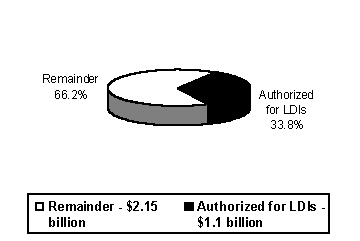
Source: LSO analysis of State Treasurer's data.
LDIs Use Permanent and Operating Funds
PWMTF.
The largest source of funding for LDIs is Permanent Wyoming Mineral Trust Fund (PWMTF) monies. Article 15, Section 19 of the Wyoming Constitution provides for an excise tax on the privilege of severing or extracting minerals, such as coal, oil, gas, trona, and others, from the ground. Statutes direct a portion of the taxes to the PWMTF, such that at the end of FY 96, the PWMTF had a balance of more than $1.4 billion.The Constitution requires that the PWMTF remain inviolate and that all income from investments be deposited in the General Fund. In FY 96, interest generated from the PWMTF was $86,526,776. This amount is nearly 20 percent of General Fund income and constitutes its second largest income stream.
While the PWMTF must remain inviolate, the Constitution allows the Legislature to invest the monies as it shall prescribe. It also directs the Legislature to define terms and conditions under which these monies "may be loaned to political subdivisions of the state." Thus, two not entirely consistent purposes for the PWMTF can be inferred from the Constitution: first, to preserve asset values in order to provide for a predictable income stream for the General Fund, and second, to under-write specific programs and projects whose public policy objectives may or may not be to achieve the maximum financial return on investment.
Statutes authorize nearly $1 billion in PWMTF investments, loans, and guarantees for LDIs. Twenty LDIs make use of PWMTF monies.
PLF.
The Permanent Land Fund (PLF) is used to account for the lands received under the Act of Admission, which were designated specifically for the state's educational system and other public institutions. Income from mineral royalties on and sales of these lands is returned to the corpus, while income from rentals, fees, and interest earnings is deposited either in the Permanent Land Income Fund or the General Fund. At the end of FY 96, the PLF amounted to more than $898 million, 93 percent of which is within the Common School Account (CSA). One LDI is authorized from the University Account within the PLF, and three others involve funds from the CSA within the PLF.Operating Funds.
The Treasurer has available for investment other funds separate from trust funds, which can be called operating funds. The amount of funds in this pool varies from day to day as revenues are deposited for all state government services and activities, and as they are used to pay the day-to-day obligations of state government. Two LDIs make use of operating funds.Farm Loan Board/State Loan and Investment Board
In 1996, the Legislature added to statutes the requirement that the five elected officials, sitting as the Farm Loan Board, adopt policy statements and provide oversight for the investment of state funds. The Board can specify groupings of state funds for which separate investment policy statements are appropriate. Policy statements will include such matters as performance benchmarks, risk tolerance, liquidity requirements, and cash flow projections.
The Board has retained a consultant to assist in carrying out these new duties, and is in the process of defining its new role. As of this writing, the Board has not taken a position on how LDIs will be incorporated into the state's investment strategy. Thus the Board's role with respect to LDIs is evolving, but at present remains unclear. In 1997, the Legislature changed the name of the Board to "State Loan and Investment Board," which is the name used in this report.
General Discussion of LDIs
History
. Individually and collectively, LDIs are a version of economically targeted investing (ETI). ETI, which aims to improve the economic well-being of the state, its municipalities, and its residents, has existed in Wyoming for at least 90 years. In 1907, the Legislature provided for state funds to be deposited with Wyoming banks; with some modifications, that program is now known as Time Deposit, Open Account, or TDOAs. Similarly, farm loans were first authorized in the 1920s and at present are the biggest LDI, with $275 million in statutory authorization.With the establishment of the PWMTF in 1974, more LDI programs and projects began to be approved, and there has been considerable activity recently. In the 1994 and 1995 legislative sessions, seven new programs and projects, authorizing $277 million, were approved. LDIs are listed on the below, and each is described in more detail on later in the report.
|
§ Farm Loans § Irrigation Loans § Home Mortgage Loans § Deferred Property Taxes § Drainage District Bonds § Joint Powers Act Loans § Local Government Bond Guarantees § Cheyenne Stage II Water Project § Shoshone Water Treatment Project § Sheridan Area Water Treatment Project § Green River/ Rock Springs Water Treatment Project § Natrona County Regional Water Treatment Project § Comm. College Bonds § UW American Heritage Center/Art Museum Project § School District Bond Guarantees § Direct Student Loans § Student Loan Stand-by § UW Advance Payment Contracts § Time Deposit Program § Hot Springs State Park Loans § Small Business Assistance Act Loans § Link Deposit Program § Clean Coal Investments § Wyoming Territorial Park Project § 1991 Industrial Dev. Bonds § 1995 Industrial Dev. Bonds |
|---|
Many Variations Among LDIs
. Just as LDIs vary in the way they are funded, they also vary as to who is the recipient of the investment. Some LDIs allow the state to benefit another public entity. For example, the state's credit can stand behind a school district's bonds; the district benefits by obtaining a reduced interest rate. Other LDIs, such as student loans and small business loans, allow the state to purchase guaranteed portions of loans, thereby assisting private individuals or businesses. These mechanisms do not violate Article 16, Section 6 of the Constitution, which prohibits the state from making loans directly to individuals or businesses.LDIs are diverse and are intended to achieve a wide variety of special purposes, some through one-time projects, and others through ongoing programs. For example, LDI projects include water treatment projects, Wyoming Territorial Park, and a loan to the American Heritage Center/Art Museum at the University of Wyoming. Examples of LDI programs are higher education loans, agricultural loans, bond guarantee programs to benefit local governments and school districts, and joint powers loans.
Actual financing vehicles vary with individual LDIs:
Over the course of 90 years, the Legislature stipulated different terms and conditions as it approved each program and project. Consequently, there is little consistency among the 26 LDIs in loan maturities, interest rates, credit terms, and other requirements.
LDIs use different mechanisms to protect the principal of the fund behind them. These protections may include one or several of the following: zero coupon bonds, assignment of mortgages or water rights, liens, federal guarantees, private insurance, loss reserve accounts, and the pledge of securities.
Finally, LDIs are not administered or monitored by one agency of state government. Rather, the authority for these programs and projects is widely dispersed among various state agencies, several private sector entities, and local project management authorities. For example, a few of the entities involved are the Wyoming Water Development Office, the Investment Fund Committee, the State Loan and Investment Board, a bank, and several joint powers boards and not-for-profit corporations.
In sum, LDIs seem to be characterized not so much by their consistency and commonalities, as by their dissimilarities. However, what they do have in common is the legislatively directed use of state funds to achieve public purposes, often at subsidized rates. Each also involves the State Treasurer's Office, which makes the actual investment on behalf of the state.
Authorizations, Allocations, and Commitments.
Throughout this report, we use certain terms to describe the status of the funds to analyze the financial performance of LDIs. A brief explanation of theses terms follows.Authorization.
For most LDIs, statutes or session laws authorize an amount of money to be used in connection with the program or project. At different times, the Legislature has adjusted some of these caps (or maximum amounts) to meet perceived needs, but it has not conducted a systematic review of the appropriateness of each program's authorization. Within the amount authorized, the funds may be deployed in the following ways:
Making Improvements.
In Chapter 2 we present a more detailed description of each LDI. These descriptions include discussion of the purpose and current need for each. We found it necessary to offer interpretations of the intent and purpose of the 26 LDIs since they are not always clearly defined in the authorizing legislation. However, these interpretations and the analysis derived from them are not intended to criticize decisions that have led to establishment of individual LDIs. Rather, we see many opportunities for the Legislature to make improvements in LDIs, and thereby better serve the long-term needs of the state. Options are presented as "Policy Alternatives" at the end of each description.
LDIs are important because they represent investment of roughly one-third of the state's investable funds. However, since no apparatus has been constructed to manage or monitor them as a group, it appears assumed that LDIs will "take care of themselves" individually. Based on the individual program and project research described in Chapter Two, we concluded they are not all performing uniformly or successfully. Thus, Chapters 3 through 6 explain the cumulative financial impacts for these investments, and suggest options for modifying, consolidating, or eliminating several. We also offer other models that could be adopted for targeted investing, as well as ideas for "raising the profile" of this group so that its overall performance can be enhanced.
Chapter 2: One-Page Descriptions of the 26 LDIs
This chapter includes one-page descriptions of the 26 programs and projects grouped by the 1995 Select Committee on Financial and Cash Flow Management as legislatively designated investments, or LDIs. Throughout the report, many, but not all, of these projects or programs are mentioned. This chapter serves as a reference to the reader for more specific information about each LDI.
The summary on the next page provides a snapshot of information about the programs and projects overall. In the material that follows, the LDIs have been grouped according to topic. For example, LDIs relating to public infrastructure are together, and specific public infrastructure projects relating to water treatment and education are together.
These 26 LDIs have been approved ad hoc throughout this century, with many different terms and conditions. The one-page descriptions of each LDI emphasize the wide diversity and disparities among them. The first LDI was authorized in 1907, only six more were authorized before 1980, and the majority have been authorized in the last 17 years: ten during the 1980s, and nine during the 1990s, five of them in 1995 alone.
The PWMTF is the fund of origination for 20 of the 26 LDIs. Four use the PLF, while two others use operating funds. Nine of the LDIs are direct loans or loan programs, and four more involve the purchase of loans. There are three bond guarantee programs and eight additional LDIs involve the purchase of bonds. Finally, two are deposit programs.
Authorizations for these LDIs range from a low of $2 million (for the Hot Springs State Park Loan Program), to a high of $275 million (for the Farm Loan Program). Seven of the LDIs are authorized for $10 million or less. Only four are authorized for $100 million or more.
Summary of 26 LDI Programs and Projects
| Name of LDI | Year | Fund Type | Authorization | Allocation |
| Authorized | Level 6/30/95 | Level 6/30/96 | ||
| Loan Programs for Individuals | ||||
| Farm Loan Program | 1921 | PWMTF | $275,000,000 | $167,090,354 |
| Irrigation Loan Program | 1955 | PWMTF | $60,000,000 | $18,248,719 |
| Home Mortgage Loan Program | 1981 | PWMTF | $60,000,000 | $9,555,155 |
| Deferred Property Tax Program | 1995 | PWMTF | $10,000,000 | $6,207 |
| Public Infrastructure Programs | ||||
| Drainage District Bond Program | 1930s | PLF - CSA | Not specified | $88,170 |
| Joint Powers Act Loan Program | 1974 | PWMTF | $80,000,000 | $24,529,135 |
| Local Government Bond Guarantee Program | 1994 | PWMTF | $100,000,000 | $0 |
| Public Infrastructure Projects (Water Treatment) | ||||
| Cheyenne Stage II Water Project (development) | 1980 | PWMTF | $35,360,965 | $30,587,825 |
| Shoshone Municipal Water Treatment Project | 1987 | PWMTF | $16,500,000 | $15,651,612 |
| Sheridan Area Water Treatment Project | 1989 | PWMTF | $6,750,000 | $6,750,000 |
| Green River/Rock Springs Water Treatment Project | 1995 | PWMTF | $24,000,000 | $1,000,000 |
| Natrona County Regional Water Treatment Project | 1995 | PWMTF | $23,000,000 | $3,000,000 |
| Public Infrastructure Programs and Projects (Educational) | ||||
| Community College Bond Program | 1967 | PLF - CSA | Not specified | $968,000 |
| UW American Heritage Center/Art Museum | 1990 | PLF- CSA | $6,000,000 | $0 |
| School District Bond Guarantee Program | 1994 | PLF - CSA | $100,000,000 | $49,956,000 |
| Education Programs | ||||
| Student Loan Stand-by Program | 1984 | PWMTF | $125,000,000 | $101,000,000 |
| Direct Student Loan Program | 1985 | PWMTF | $15,000,000 | $14,484,760 |
| UW Advance Payment Contracts | 1995 | PWMTF | $10,000,000 | $0 |
| Economic Development and Other Programs and Projects | ||||
| Time Deposit, Open Account Program | 1907 | Operating Funds | Not specified | $88,029,000 |
| Hot Springs State Park Loan Program | 1967 | PWMTF | $2,000,000 | $1,247,194 |
| Small Business Assistance Act Loan Program | 1984 | PWMTF | $35,000,000 | $9,629,651 |
| Link Deposit Program | 1986 | Operating Funds | $0 | $5,055,306 |
| Clean Coal Investment Program | 1987 | PWMTF | $30,000,000 | $20,700,000 |
| Wyoming Territorial Park Project | 1989 | PWMTF | $10,000,000 | $10,000,000 |
| 1991 Industrial Development Bonds | 1991 | PWMTF | $25,000,000 | $0 |
| 1995 Industrial Development Bonds | 1995 | PWMTF | $10,000,000 | $0 |
Farm Loan Program
Initiated in 1921, the Farm Loan Program is currently authorized under W.S. 11-34-101 through 203, as a permanent fund investment which provides long-term, low-interest loans for agricultural operators. By statute, the State Loan and Investment Board issues nonnegotiable debenture bonds, and the proceeds are loaned to private entities. The State Treasurer is authorized to invest up to $275 million in these bonds using permanent funds. The program is administered by the Office of State Lands and Investments.

Program Description:
Loans may be used to purchase farm lands, equipment, fertilizer, livestock, to provide for buildings and improvements, and to liquidate the indebtedness of the owner. The maximum loan amount available to an individual is $400,000, for a 30-year duration. Borrowers must pay a $100 application fee as well as a one-percent loan origination fee, which are placed in a statutory loss reserve account.
The statutory interest rate ranges from 4 to 10 percent, but program rules state that an 8 percent interest rate is charged on loans made for 50 percent of the appraised value of the land, and 9 percent for loans made for 50 to 60 percent of appraised land value. The Board's practice is to secure loans with a first mortgage.
In 1996, the program had an average delinquency rate of 7.1 percent, representing 101 loans. Principal and interest payments are due on December 1st, and program rules require delinquent borrowers to submit a repayment plan to the Board if a payment is not made by March 1st. By November of 1996, all but six of the delinquent loans had either been brought current or were on repayment plans. The Office of State Lands and Investments charges a 10-percent late fee for delinquent loans.
Recent Use:
According to program officials, this program represents approximately 40 percent of the long-term agricultural real estate lending occurring in the state. In the past five fiscal years, the loan volume was the greatest in 1992 at $201,485,800 outstanding; this represented 73 percent of the amount available for loans. In FY 96, approximately 61 percent of the statutory authorization had been loaned out. The funds authorized are revolving monies, so principal paid on existing loans is available for subsequent lending.
|
Policy Alternatives: The Legislature may wish to consider maintaining the current authorization for this program. In the last five years, the program has consistently used 60 to 70 percent of its authorization and returns have outperformed the rest of the Treasurer's portfolio. However, now that the Treasurer is authorized to invest in equities, future returns may not compare as well. There may be room within the current authorization to absorb the demand for the irrigation loan program, also administered by Office of State Lands and Investments. |
Irrigation Loan Program
The Legislature authorized investment in irrigation loans in 1955 (W.S. 11-34-301 and 302) for the purposes of conservation, distribution, and utilization of water in the state. To provide capital for these loans, the State Loan and Investment Board may issue nonnegotiable debenture bonds for up to one-third of the permanent funds or $60 million, whichever is less. By statute, the Treasurer shall invest in these bonds using permanent funds. Half of the authorization must be reserved for small water development projects not to exceed $150,000. The Office of State Lands and Investments administers the loan program in conjunction with the farm loan program.

Program Description:
Loans may be made to finance the purchase, construction, and installation of agricultural water development projects. The program only finances irrigation development on dry land. Borrowers may not refinance existing irrigation loans or use the funds for operating expenses.
The Board may make loans to water districts, agencies of state and local government, individuals, corporations and associations. Loans may be made in an amount of up to 70 percent of the appraised value of undeveloped dry land. The loans bear interest between 4 and 6 percent. The term of each loan is set by the Board based on the useful life of the equipment financed, not to exceed 40 years for construction of permanent storage.
The Board's practice has been to secure loans with a first mortgage, and take a purchase money security interest in all equipment and fixtures purchased with loan proceeds. Borrowers pay a fee of one percent of the loan, which is credited to a loss reserve account. In 1996, an average of 5 of 65 loans were delinquent, representing 8.3 percent of the outstanding loans. By November of 1996, all but one of the delinquent loans were current or on repayment plans. Delinquent borrowers are assessed a 10-percent late fee.
Recent Use:
Demand for the program has not been remarkable recently, with only two new loans approved in the past five fiscal years. Only 30 percent of the statutory authorization available was allocated for this program in FY 96.
|
Policy Alternatives: The Legislature may wish to consider either reducing the authorization for this program, or eliminating the current program and combining it with the existing authority in the Farm Loan Program. According to program managers, a significant amount of idle acreage has already been irrigated through this particular financing tool. Thus, it appears unlikely that the program would experience a marked increase in demand in the future. |
Home Mortgage Loan Program
The Legislature authorized the investment of Wyoming home mortgage loans in 1981 to assist in providing housing to persons of moderate income. The State Treasurer is authorized to invest and keep invested up to $60 million in this program through W.S. 9-4-701(d).

Program Description:
The State Treasurer may purchase mortgage loans or mortgage loan pools of eligible individuals. Eligibility restrictions include a maximum gross family income of $45,000 and maximum purchase price of $85,000. The minimum interest rate assigned in statute is 10 percent, but it allows temporary modifications at the concurrence of the Governor, State Treasurer, and Attorney General if the corpus or income of the PWMTF is at risk due to possible default by mortgagors. The State Treasurer must also obtain agreement of all parties to the mortgage.In addition to a valid first lien upon the real property, all mortgages purchased require insurance either by government agencies or through private mortgage insurance. Under the current arrangement, a master servicer provides all of the accounting of pooled mortgages and makes payments to the state on a monthly basis. In two instances, a large number of defaults during the most recent energy bust resulted in the depletion of the pool insurance on the mortgage pools owned by the state. This circumstance puts the state at risk of lower return or even potential losses.
Recent Use:
The State Treasurer purchased the most recent loan pool prior to 1990 with the vast majority of activity in the early 1980s. The allocated portion of the authorization has decreased from 62 percent in FY 92 to 16 percent in FY 96, reflecting the payment of existing loan pools. Higher-than-market interest rates under the current financial climate have effectively suspended the purchase of new loans or loan pools by the state. The Legislature set the original authorization at $100 million and increased the authorization to $150 million in 1984. In 1990 the Legislature reduced the authorization to its current level of $60 million.|
Policy Alternatives: When active, the Home Mortgage Loan Program appears to achieve its purpose of assisting to provide housing to Wyoming residents with moderate income. Nevertheless, the Legislature may want to consider including a provision for an adjustable interest rate dependent upon financial conditions, reducing the statutory interest rate to increase use, or significantly reducing the level of authorization. The program is effectively inactive under present economic conditions, although it does provide an above average rate of return. |
Deferred Property Tax Program
At the local level, the Deferred Property Tax Program, authorized in W.S. 39-3-101, provides a mechanism for temporary tax relief for individuals meeting specific criteria. Currently, there are only two actively participating counties: Teton and Sheridan. The state's role in the deferred property tax program is to reimburse counties for any potential lost revenues from individual participants in the Deferred Property Tax Program within a specific county.

Program Description:
Initiated in 1995, the state's reimbursement protects participating counties from any potential reduction in revenue through the use of the Deferred Property Tax Program. Participating counties must charge a statutory interest rate of 4 percent compounded annually to qualified individuals with limited income, the elderly, or handicapped. Another subsection allows individuals who purchased their property prior to December 31, 1987, the same tax deferral advantages, but at a different interest rate. Individuals qualifying solely under this provision are charged an interest rate equal to the average rate of return on all Permanent Mineral Trust Fund investments for the preceding calendar year.The board of County Commissioners in each county decide locally whether to offer the program. The Department of Revenue must then approve the county's plan. W.S. 9-4-701(m) exclusively authorizes the State Treasurer to invest permanent funds in the reimbursement of deferred property taxes and interest. The program provides property tax deferral not a tax refund.
Recent Use:
In the initial two years since inception, the level of use of the program has not met expectations. Currently, only 0.06 percent of the authorization is outstanding. In addition, there are alternative tax relief measures such as the recently-enacted property tax relief program, W.S. 39-3-401, which removes the property tax liability for qualified applicants. Counties are not compensated for any potential lost revenue under this alternative program.|
Policy Alternatives: The Legislature may wish to reconsider this program within the context of property tax relief. Based on both the minimal individual and county participation rates, the program may have substantial excess authorization. Additional improvements might include increasing awareness through publicity and education for property owners and county administrators. Although the program is achieving its intended purpose, only a small number of property owners are participating in the program. In addition, the state is receiving a less-than-market return on the outstanding investment. |
Drainage District Bond Program
The State Treasurer invested in drainage district bonds during the 1930s. Drainage districts issued bonds at that time to finance the construction, repair, reconstruction, enlargement, extension or improvement of drainage systems. W.S. 41-9-256 through W.S. 41-9-259 authorizes drainage districts to issue bonds. However, Wyoming statutes do not provide a specific level of authorization or even mention the Treasurer's ability to invest in such loans. The Treasurer's Office current role is to collect payments on the existing bonds.

Program Description:
The bonds were purchased using Common School Account monies from the Permanent Land Fund. Current statutes do not include provisions for interest rates and bond duration, but according to officials in the Treasurer's Office, interest rates on the bonds varied from 2 to 4 percent. Bond maturation periods were set as long as 50 to 100 years. No loss reserve account was established for this program in case the drainage districts could not meet their bond obligations, nor was a penalty established for late payments.
Recent Use:
No new investments have been made for more than half a century. According to the Treasurer's Office, this program was authorized many years ago and the existing bonds are nearly retired. As of March 14, 1997, there was only one bond outstanding totaling $34,500.
|
Policy Alternatives: The Legislature may wish to discontinue this very old program, although no specific action may be necessary. This bond program may be instructive because it demonstrates that certain terms can create a less-than-optimal investment for the state, given the low interest rates and extended maturities on the bonds. If presented with similar opportunities in the future, the Legislature may wish to consider requiring strict program protections and standards to prudently evaluate the return against the public policy purpose of an investment. |
Joint Powers Act Loan Program
Authorized by the Legislature in 1974, through W.S. 16-1-109 and W.S. 16-1-110, the Joint Powers Act Loan Program provides loans to local government entities to finance infrastructure improvements. The authorization for this loan program is $80 million. Loans are approved by the State Loan and Investment Board, and the program is administered by the Office of State Lands and Investments.
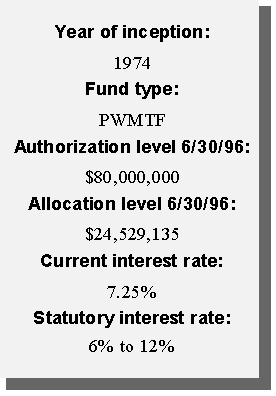
Program Description:
The Board is authorized to make loans to one or more agencies or joint powers boards for infrastructure development and capital construction. A sampling of projects that have been funded include: water and sewer systems, street improvements, electrical system upgrades, and landfill projects.
Although the statutory interest rates for these loans is set at a minimum of 6 percent and a ceiling of 12 percent, the Board currently provides loans at 7.25 percent interest, with 40-year durations. The Board places a lien on the financed infrastructure for collateral. Borrowers may use loan proceeds for operating expenses, but they cannot seek a new loan to refinance an existing joint powers loan. Since 1979, loans have only been made for facilities generating user fees.
For loans approved after July 1, 1996, the borrower is required to pay a one-percent loan origination fee, which is credited to a statutory loss reserve account. The account was established by the Legislature in 1996 in case entities default on the loans. In the past, if the borrower could not make loan payments, the State Loan and Investment Board would provide federal mineral royalty grant monies to bring the loan current.
Recent Use:
During the past five fiscal years, outstanding loans have ranged from a high of almost 50 percent of the funds available in FY 92, to 31 percent in FY 96. Payments made on existing loans are available for new loans, so the permanent funds constitute a revolving source of money for joint powers loans.
|
Policy Alternatives: The Legislature may wish to reevaluate its historic approaches to funding local infrastructure improvements before making any decisions about whether or not the amount available for this program is appropriate. Local entities can tap a number of sources to fulfill infrastructure needs, and an analysis of how best to achieve these needs could justify either a reduction or an increase in this program authorization, depending on how the state decides to proceed. |
Local Government Bond Guarantee Program
The Legislature established the Local Government Bond Guarantee Program in 1994 to reduce the interest rate at which local government bonds may be issued by guaranteeing payment of their debt service. This approach eliminated the need for local governments to purchase bond insurance to get optimal interest rates on their bonds.
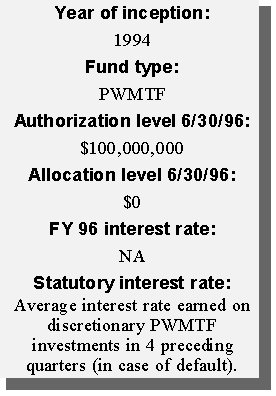
Program Description:
Statute (W.S. 9-4-1002) calls for the State Loan and Investment Board to administer the program by reviewing applications and granting guarantees to creditworthy cities, towns, and counties. Local governments approved for the program forward their debt service payments to the State Treasurer who makes the payments to appropriate bonding agents. If a local government cannot make a payment, the State Treasurer makes the payment from the $100,000,000 authorized for this program. Any funds that might be committed under this program would still be available for investment by the State Treasurer.By making this payment, the state makes a loan to the local government at an interest rate equal to the average interest rate earned on discretionary permanent fund investments in the four calendar quarters preceding the quarter in which the loan occurs. To repay the loan, the local government forfeits to the state its next distributions of federal mineral royalties and severance taxes.
Recent Use:
This program has never been used because it is not operational. In order to implement it, state officials say that additional work must be done to get Internal Revenue Service approval, including getting the PWMTF officially declared a perpetual trust fund. State officials surveyed local governments and received no indication of interest in the program, so they have not pursued the IRS ruling.
|
Policy Alternatives: One state official we interviewed commented that this program may be an important part of the solution if the state determines to reexamine how it funds local government infrastructure. Furthermore, a local government representative said that it would be worthwhile to pursue making this program operational before local infrastructure built during the "boom" years needs replacing. However, the use of this program (assuming that it can be made operational) depends upon local governments becoming more comfortable with incurring private placement debt. |
Cheyenne Stage II Water Project
In 1980, the Legislature enacted W.S. 41-2-202 through 41-2-211, authorizing a loan from the PWMTF to the city of Cheyenne for the Stage II project. Wyoming's Constitution gives the Legislature authority to loan monies from the PWMTF to political subdivisions in Article 15, Section 19. Stage II expanded the city's water supply by constructing facilities to collect and hold additional water from the Little Snake River and Douglas Creek drainages and transport it to the existing Cheyenne system. In addition to the loan, the state granted $23 million in water development funds to the project.
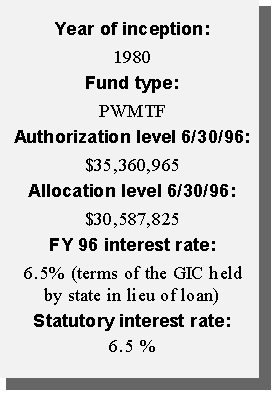
Project Description:
The Legislature made the original loan at $40 million. However, this amount was modified over time and the loan amount currently reflected in statute is $35,360,965. Statute called for the State Loan and Investment Board to set the term and interest rate for the loan, which it set at 30 years and 6.5 percent. To obtain the loan, the state required the city of Cheyenne to get voter approval of the debt and to pledge project revenues toward its repayment as evidenced by the issuance of general obligation bonds to the state.Initially, the now defunct Department of Economic Planning and Development (DEPAD) was responsible for the administration of this loan, including approving expenditures for project engineering and construction work. In 1985, the state administrative responsibility shifted to the Economic Development and Stabilization Board (EDSBD), which was legislatively created to establish the state's objectives in economic development.
Recent Use:
In 1988, the State Loan and Investment Board sold this loan through a series of bonds issued on the private market. The result of this sale was an upfront profit of $3.6 million to the General Fund. With the bond sale proceeds, the state purchased a guaranteed investment contract (GIC) with the same terms as the original loan to the city of Cheyenne. The city's payments were not affected by this sale, and it has since refunded its bonds for more favorable terms. As a result of this project and others financed in part by the Wyoming Water Development Commission, the city of Cheyenne has raw water capacity for a population of 100,000 and is selling some excess water to the Town of Saratoga. Two-thirds of the proceeds of that sale revert back to the state.|
Policy Alternatives: The sale of state loans for local government revenue producing projects may offer incentives to both the state and the borrowers. If the state maintains the loans until the local government projects are producing revenues, as it did with Cheyenne Stage II, the local governments may be in a better position to bond when project revenues can meet debt service. If backed by the local government bond guarantee program (see Chapter 2 - local government bonds guarantee program), local governments may be able to bond at reduced rates, and bonding would make the PWMTF funds involved in the loans available for other uses. |
Shoshone Municipal Water Treatment Project
The Shoshone municipal water treatment plant complements the Shoshone municipal pipeline project that provides water from the Buffalo Bill Dam to the communities of Cody, Powell, Byron, Lovell, Deaver, and Frannie as well as rural residents in Park and Big Horn counties. Several of the communities and rural residents in this area were facing bad water and water shortages. In addition, there were water treatment needs in Cody. Thus, the Wyoming Water Development Commission (WWDC) encouraged a regional system as the most effective way to meet these needs. In 1987, the Legislature approved water development funding totaling $36,750,000 in grants and loans for the pipeline project, and this loan from the PWMTF for the treatment project.
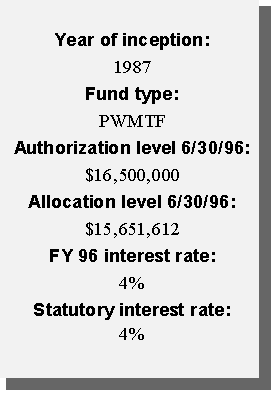
Program Description:
Using constitutional authority stated in Article 15, Section 19, the Legislature authorized a $15 million loan in session laws to design and construct the treatment plant. The Legislature increased the PWMTF loan amount to $16.5 million in 1990. The statutory interest rate is 4 percent, which began accruing in 1993, one year after the Wyoming Water Development Commission (WWDC) determined the project to be substantially complete. The term of the loan is 50 years, also beginning a year after project completion. In 1994, the Legislature granted the joint powers board an additional two-year deferment of payment of interest and principal, and of interest accrual. The board resumed payments in September of 1996, and the loan has been amortized over the remaining 46 years of the term.This loan is administered by the WWDC, under the same project agreement it uses to administer WWDC projects. This requires project sponsors to offer all assets, including existing facilities and water rights, as loan collateral. Further, WWDO project managers must approve each project expenditure.
Recent Use:
The water system is complete and currently sells treated water to the communities named above as well as to the Northwest Rural Water District. In total, these wholesale customers serve a population estimated at 19,200. Between 1992 and 1995, the number of customers served increased while the amount of water sold decreased. The joint powers board attributes this to increased water conservation efforts on the part of users. In 1996, water sales as well as the number of customers increased.|
Policy Alternatives: The joint powers board sponsoring this project had approximately $15 million in PWMTF loan funds outstanding for 4 years at 0 percent interest before project revenues were adequate to meet its debt service. Hence, with water projects, flexible debt service requirements may be necessary in the first years of operation, as well as during construction. Therefore, to be feasible for some projects, financing alternatives to the direct loan approach must make allowances for delayed debt service capabilities. |
Sheridan Area Water Treatment Project
The Sheridan Area Water Treatment Plant complements the Sheridan Area Water Supply Project that provides water to residents in the city of Sheridan as well as to rural residents in the Big Goose and Little Goose valleys. The area water supply and treatment system was built to address water supply and quality problems in the Sheridan area that included violations of the Safe Drinking Water Act. In addition to this direct legislative loan, the state made loans and grants through the Wyoming Water Development Commission totaling $37,206,000 to finance the system's water development needs.
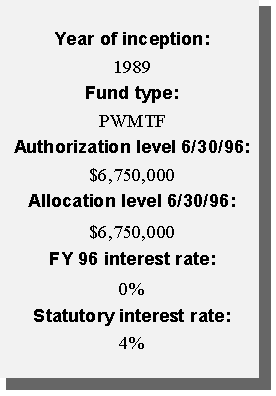
Program Description:
In 1989, using constitutional authority stated in Article 15, Section 19, the Legislature authorized a $6,750,000 loan in session laws to the Sheridan Area Water Joint Powers Board from the PWMTF to design and construct water treatment facilities: one new plant and rehabilitation of another. The statutory interest rate is 4 percent, to begin accruing 5 years after the WWDC determines the project to be substantially complete. The loan's 50-year term also begins when the project is judged complete. Although not required by the Legislature, Sheridan County residents approved a capital facilities tax to partially fund the total project.WWDC administers this loan, under the same project agreement it uses to administer WWDC projects. This agreement requires project sponsors to offer all assets, including existing facilities and water rights, as loan collateral. Further, WWDO project managers must approve all project expenditures.
Recent Use:
WWDC determined that the treatment facilities financed with this loan were complete in May 1994, and thus the first payment comes due in December of the year 2000. The water system is currently providing water to a population estimated at 19,000, including 4,000 residents who previously did not have treated water. According to a joint powers board official, this project has enabled growth to occur in areas where poor quality drinking water wells and residential density previously would have prohibited it.
|
Policy Alternatives: This project has more favorable terms with respect to payment and interest deferrals than do the loans to Shoshone, which preceded it, and to Natrona County Regional and Green River/Rock Springs, which were approved six years later. Further, interest rates for the subsequent direct legislative loans are twice the rate of this loan. A more structured process for considering these loans may result in more equitable terms statewide. |
Green River\Rock Springs Water Treatment Plant
Green River and Rock Springs, as well as residents in the area between the two municipalities, draw water for municipal and domestic use from the Green River and have shared a water treatment plant. Water treatment improvements were necessary to complete a regional project, financed by WWDC, to improve intake and transmission capabilities. Site contamination at the existing water treatment plant prohibited expansion of that facility, so the joint powers board sponsoring this project sought funding from the Legislature for a new plant. The board was also awarded $18.8 million in Abandoned Mine Land (AML) funding for this project, to be received on a phased basis.
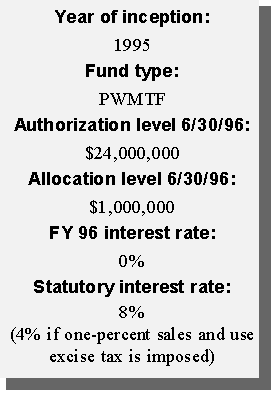
Project Description:
In 1995, using constitutional authority stated in Article 15, Section 19, the Legislature approved a $24 million loan in session laws from the PWMTF to the joint powers board at 8 percent to design and construct a water treatment plant and the appurtenances necessary to make the system functional. The loan's term is 45 years, beginning the date the plant becomes operational. The Legislature also gave the board the option of taking a $17.4 million loan at 4 percent for 25 years if the county imposed a one-percent sales and use excise tax to pay parts of the project's cost. When completed, the treatment plant will have a maximum capacity of 32 million gallons per day to provide treated water for municipal and domestic purposes in the Green River/Rock Springs area.This loan is administered by the WWDC, under the same project agreement it uses to administer WWDC projects. This requires project sponsors to offer all assets, including existing facilities and water rights, as loan collateral. Further, WWDO project managers must approve each project expenditure.
Recent Use:
According to the State Treasurer's Annual Report, by the end of FY 96, the project sponsor had drawn $1 million of the total amount available in the loan. The board has awarded a construction contract, with plant completion projected for late 1998. An industrial user has requested to purchase water from the board for future expansion of its operations east of Rock Springs. By law, sales of water for purposes other than municipal and domestic use must be approved by the WWDC, and sales revenues must be used to retire the principal of state loans. Once those loans are repaid, the state continues to receive 67 percent of the sale revenues.
|
Policy Alternatives: With the AML funds and the potential sale proceeds, as well as the settlement from a related lawsuit, this sponsor is in the position of possibly being able to repay the PWMTF loan at an accelerated rate. It also may not have needed the interest and payment deferrals until the project becomes operational, thus saving the state the opportunity cost from loaning at 0 percent until the project is completed. The Legislature may want to consider requiring accelerated repayment of future direct loans if certain circumstances make sponsors capable of doing so. |
Natrona County Regional Water Treatment Project
The Natrona County Regional Water Treatment Project is the water treatment aspect of a regional water system, now called the Central Wyoming Regional Water System. Studies conducted by the Wyoming Water Development Commission (WWDC) in the early 1990s indicated that this area could be effectively served through a regional system. As a result, a joint powers board comprised of representatives of some regional municipalities, the county, and water districts, formed and then sought state funding for the system. Current board members are the city of Casper, Midwest\Edgerton, Natrona County, and the Pioneer and Wardwell Water and Sewer Districts. In addition to this loan, the state has funded this system through WWDC grants and loans totaling $21,300,000.
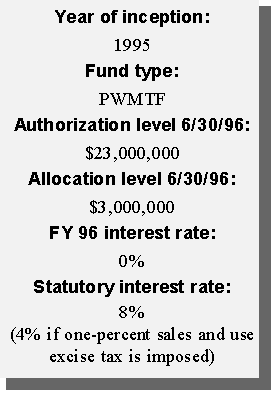
Project Description:
In 1995, using constitutional authority stated in Article 15, Section 19, the Legislature approved a $23 million loan in session laws at 8 percent interest to the joint powers board to increase the capacity of an existing water treatment plant and provide the appurtenances necessary to make the project functional. The loan's term is 30 years, beginning the date the plant becomes operational. The Legislature also gave the sponsor the option of taking a $14 million loan at 4 percent for 25 years if the county imposed a one-percent sales and use excise tax to pay part of the project's cost. When completed, the system will have the capacity to serve the projected population through 2015, or 80,000 regional residents.This loan is administered by the WWDC, under the same project agreement it uses to administer WWDC projects. This requires project sponsors to offer all assets, including existing facilities and water rights, as loan collateral. Further, WWDO project managers must approve each project expenditure.
Recent Use:
According to the State Treasurer's Annual Report, by the end of FY 96, the project sponsor had drawn $3 million of the total amount available in the loan. Some of these funds have gone for treatment plant design and some for joint powers board operations. The board is slated to award a construction contract late this year, with the project estimated to be completed in late 1999. Recently, the issue of treatment plant operation has generated some controversy. Currently, the city of Casper and the board are negotiating a contract whereby the city would operate the plant as a contractor.
|
Policy Alternatives: Direct legislative loans, such as this one, are attractive to sponsors of large infrastructure projects because they commit, up-front and without competition, the total amount of money necessary to plan and construct the projects. Furthermore, the Legislature has made these loans available with interest and payment deferrals, and sometimes at low interest rates. The Legislature might consider other ways to provide these benefits, as well as how these loans complement or undermine other state efforts to finance local government infrastructure, including existing bonding authorities and/or guarantees. |
Community College Bond Program
Community colleges were given the power to bond through W.S. 21-18-314 in 1967, and at that time the Treasurer was authorized to invest any permanent state funds in these bonds. The bonds were purchased using Common School Account monies from the Permanent Land Fund. Wyoming statutes do not specify a defined level of authorization for this program. Currently, the Treasurer's Office only has involvement in the program to collect payments on the existing bonds.
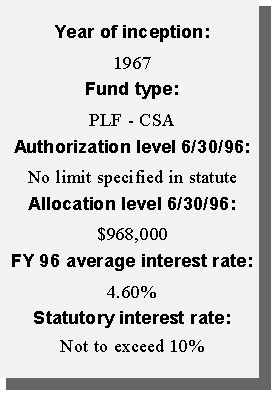
Program Description:
This bonding program allowed community colleges to obtain capital to finance the construction and improvement of facilities. Community colleges are authorized to bond for the purpose of acquiring, erecting, and equipping facilities for the college. The interest rates on the bonds purchased range from 3.5 to 6 percent. Maturation on the bonds may not exceed 40 years. Statutes state that if a community college defaults on the bond debt service, the Treasurer is allowed to withhold any appropriation due to the community college to cover the default as authorized in W.S. 21-18-206.
Recent Use:
According to the Treasurer's Office, the state has not invested in community college bonds since the 1970s. All payments are current and as of FY 96, there was $968,000 outstanding in this program, representing seven bonds. The last bond will be retired in 2009.
|
Policy Alternatives: According to the State Treasurer's Office, this program was authorized many years ago and the bonds purchased are nearly retired. The Legislature may wish to consider eliminating this program as an investment option, due to the lack of activity. However, before making decisions about the program's viability, the Legislature may want to incorporate a review of it into a broader review of the state's approaches to funding local infrastructure improvements. |
UW American Heritage Center/Art Museum
In 1990, through session laws, the Legislature authorized the University of Wyoming to borrow up to $6 million from the University's account in the Permanent Land Fund to construct the American Heritage Center/Art Museum. Total financing for this $19 million facility came from General Fund appropriations and matching nongovernmental funds. The Legislature authorized this loan, essentially a bridge loan, to enable the University to contract for the project's construction while it awaited pledges of the matching funds.
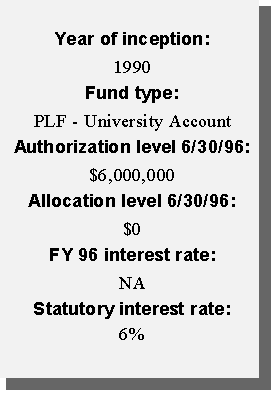
Program Description:
The loan from the University's Permanent Land Account was at 6 percent for 10 years. The Legislature did not increase General Fund appropriations to offset any reductions in the University's Permanent Land Fund account earnings that resulted from the terms of the loan. To receive loan funds, the University had to certify to the State Treasurer that all of its cash nongovernmental sources for the project were expended.
Recent Use:
The University requested only a maximum of $1,050,000 from the $6 million authorization, and the entire loan has now been repaid.
|
Policy Alternatives: The flexibility this loan provided was a complement to the University's fundraising efforts. Further, since the University essentially borrowed from itself, it did not harm any other entities by temporarily decreasing income from a permanent fund. If this approach were used heavily for University capital needs, however, there would be resulting decreases in the general operation revenues the University receives from its PLF earnings, which could become problematic. |
School District Bond Guarantee Program
Authorized in 1994 through W.S. 9-4-1001, the School District Bond Guarantee Program reduces school district borrowing costs to finance infrastructure and improvements. The program allows eligible school districts to obtain a higher bond rating, and thus a lower interest rate, by pledging the state's resources from the Common School Account to guarantee the payment of school district bonds if they default. W.S. 9-4-701(j) authorizes the Treasurer to pledge up to $100 million from the Common School Account to guarantee school district bonds. Any funds committed under this program as a guarantee would still be available for investment by the State Treasurer. The Office of State Lands and Investments administers the program, and the State Loan and Investment Board approves creditworthy school districts to participate in it.
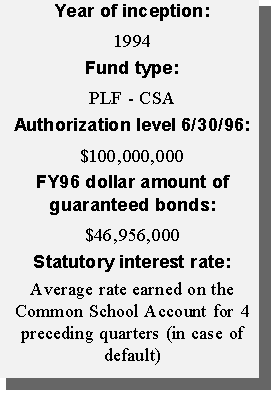
Program Description:
The state will only guarantee investment-grade, general obligation bonds. The district must deposit sufficient funds with the Treasurer to forward the principal and interest payments to the paying agent. The Treasurer acts as the intermediary for the bond payments. If the district does not make a payment, the state will step in and make the payments using monies from the Common School Account. If this were to occur, the state would effectively loan the funds to the district. The loan would be repaid from the district's next share of payments from the Common School Account and the Foundation Program. The interest earned on the loan would accrue at the same rate as the average interest earned on investments in the Common School Account for the four preceding quarters.
Recent Use:
The program has only been operational since April of 1996, and currently there are eight school districts participating in the program. In FY 96, about 47 percent of the guarantee had been leveraged, providing an estimated net savings to school districts of more than $1 million. At this point, no districts have defaulted on their bond payments, so the state has never had to cover district debt service. Bond rating companies believed that the $100 million authorized for the program could be used to guarantee up to $300 million in school district bonds. However, the Attorney General's Office recently issued an opinion that the statutory authorization could guarantee no more than $100 million in bond principal.
|
Policy Alternatives: The Legislature may wish to consider amending program statutes to clarify the state's role in this program, given the recent Attorney General's opinion that the state can only leverage one dollar to guarantee one dollar bonded by the school districts. If the Legislature believes this is a valid program, amendments to the authorizing legislation will likely be necessary, considering that almost half of the guarantee is already committed. However, the outcome of school finance reform could also have a bearing on the feasibility of this program. |
Student Loan Stand-By Program
The purpose of the Student Loan Stand-By Program is to provide the lowest interest possible on bonds issued by the Wyoming Student Loan Corporation (WSLC) and perhaps in the future, the Wyoming Higher Education Assistance Authority. This favorable bond interest rate, in turn, affords students the lowest interest rate practical for the purpose of higher education loans.
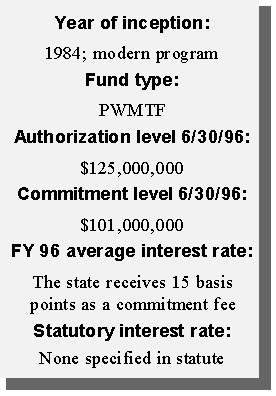
Program Description:
The Permanent Mineral Trust Fund provides a credit enhancement for the purpose of issuing bonds at the best possible rate. The state of Wyoming agrees to purchase loans held at any time the WSLC, or other applicable entity, is unable to pay interest on or principal of any of its outstanding bonds on any regularly scheduled interest or principal payment date. The WSLC compensates the state by contract with a 15 basis point commitment fee for the services rendered.If the WSLC, or other applicable entity, exercises the stand-by commitment, the state would make the payment due to the bondholders and take possession of the student loan assets. The U.S. government and other guarantors guarantee and insure the student loan assets. If the state ever did need to exercise the commitment, it would receive interest at the rate of the original student loan, less a servicing fee. This rate would be similar to the direct student loan program rate. The State Treasurer may enter into these agreements as provided in W.S. 21-16-113 only with the approval of the Governor and the advice of the Attorney General.
Recent Use:
Over the past five fiscal years, the outstanding commitment under this program ranged from $71 million to $101 million. In 1997, the Legislature passed HB 192 which increases the total authorization from $125 million to $175 million. The WSLC has never exercised the guarantee nor missed an interest payment; therefore, no funds are actually outstanding under this program. Thus, any funds committed under this program are still available for investment by the State Treasurer.
|
Policy Alternatives: The Legislature could continue to monitor the Student Loan Stand-By Program. The state will earn approximately $180,000 in commitment fees from the current balance of $121 million in commitments. Moreover, the Wyoming Higher Education Assistance Authority is becoming established and may also participate under this program in the future. It is important to consider both the total authorization and the commitment level of the student loan guarantee program when considering future obligations of permanent funds. |
Direct Student Loan Program
The Direct Student Loan Program provides the State Treasurer the option to invest in student loans of Wyoming students. The state investment of permanent mineral trust funds intends to improve the educational opportunities of students in Wyoming for higher education by providing the necessary capital for student loans in the absence of any direct appropriation.
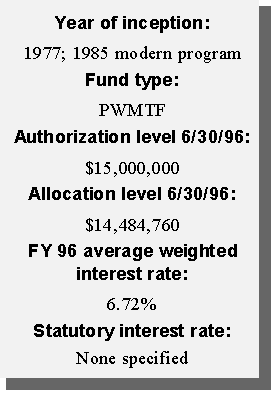
Program Description:
Authorized through W.S. 9-4-701(f), the State Treasurer may purchase nondelinquent federally guaranteed or insured student loans from any non-profit Wyoming corporation. Currently, the Treasurer purchases loans exclusively from the Wyoming Student Loan Corporation (WSLC).Historically, the return has been comparable to other government guaranteed investments. There are numerous protections of the state's investment in place. First, the WSLC repurchases any loans that are in default more than 90 days. Second, there are a number of private guarantees on the loans, and ultimately, all loans carry the guarantee of the federal government as well. The program appears to be sound having experienced no losses. The state pays the WSLC a 1.75 percent servicing fee for the administration of these loans.
Recent Use:
The funds allocated for direct student loans fluctuated between 0 percent and 97 percent of the authorization over the past five fiscal years. This fluctuation is typical of the program since the WSLC often uses these funds and others as a cash flow bridge between bond issuances. The 1997 Legislature passed HB 192, which increases the authorization for the direct purchase of higher education loans from $15 million to $25 million.
|
Policy Alternatives: This program appears to be achieving its intended purpose. It is making use of its 1996 authorization level, and with the recent statutory increase, has some room for expansion. The rate of return is fairly competitive compared to other state investments, but it does net a slightly lower rate of return after payment of fees. The Legislature should to continue to monitor the program's performance. |
UW Advance Payment Contract Program
In 1987, the Legislature passed enabling legislation authorizing the UW advance payment of tuition program. Inconsistent with the name, this program provides a mechanism by which families can purchase contracts for the costs of tuition, fees, and room and board at the University of Wyoming or any of Wyoming's community colleges. The contracts require advance purchase of 10 to 18 years prior to attendance. The authorization for the State Treasurer to invest permanent funds in the guaranteed portion of nondelinquent loans made to finance these contracts is outlined in W.S. 9-4-701(n) while W.S. 21-16-501 through 21-16-505 provide the authorization for the program.
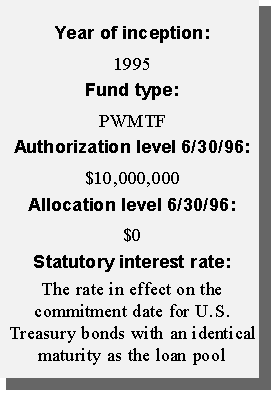
Program Description:
The intent of the authorization of permanent funds in 1995 is to assist in providing funds for loans made to purchase contracts for the advance payment of higher education contracts. The State Treasurer is responsible for the investment of the guaranteed portion of nondelinquent loans made to finance advance payment contracts. However, a board consisting of the State Treasurer, the deputy treasurer of the University of Wyoming Board of Trustees, and the executive director of the Wyoming Community College Commission is responsible for administering the advance payment program.Recent Use:
None of the authorized $10 million in permanent funds is outstanding. The three member administering board has decided to suspend the program. Although the advance payment program received significant interest and support in its initial years, it had become less attractive by 1995, and program administrators believe future use of this program is unlikely. The reasons behind the disuse include estimates of rising tuition costs, conservative predictions of investment performance, and small numbers of potential participants.|
Policy Alternatives: The Legislature could consider debating the merits of both the Advance Payment Contract Program and the investment mechanism associated with the contracts. Program administrators have decided to no longer offer the program, making the authorization of permanent funds to assist in financing unnecessary. The Legislature could look critically at the circumstances surrounding the suspension of the program, encourage its reactivation, redesign the advance payment program, or repeal the authorization of permanent funds. |
Time Deposit, Open Account Program
Time deposit, open account (TDOA) refers to a program through which the Treasurer deposits state funds with Wyoming financial institutions for the fiscal year at rates based on the 90-day Treasury bill yield for the previous quarter. W.S. 9-4-801 through 818 authorize TDOAs.
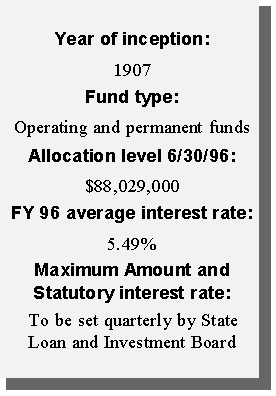
Program Description:
TDOA is an optional program, and the banks and savings and loans that choose to participate must sign a contract, collateralize the deposits fully, and pay interest to the state quarterly. As a result of 1997 legislation, the duties of the Board of Deposits in overseeing this program were transferred to the Farm Loan Board, now renamed the State Loan and Investment Board.
When initiated in 1907, the purpose of the program was to ensure the safekeeping of the state's money, but over time, the purpose of the program has evolved. While statutes are not explicit about the current purpose, TDOAs provide Wyoming banks with a source of stable, reliable, and rationally-priced funding. They can assist banks that lack an asset base sufficient to meet lending needs associated with the impacts of growth. Finally, according to the state banking commissioner, TDOAs enable Wyoming's financial institutions to continue to generate loans to capital intensive sectors of the state's economy. Nevertheless, there are no performance standards for the TDOA program that would indicate whether specific desired outcomes have been achieved.
Recent Use:
In FY 96, the program placed $88,029,000 on deposit with 46 different financial institutions in Wyoming. This represents a 45 percent increase over FY 92, when $60,557,000 was deposited. In the years 1992 through 1996, interest rates ranged from 3 percent to 5.80 percent. For FY 96, the Treasurer reported an annual opportunity cost based on realized yield of $1,672,551. As a result of a 1997 legislative change, either party to the contract may now withdraw from the contract with 45 days' advance notice.
|
Policy Alternatives: The Legislature may wish to debate the merits and costs of this program. It assists the banking industry and provides the state a predictable rate of return, but the opportunity costs are significant and the funds are not immediately available to the State Treasurer. The Legislature could consider establishing a statutory cap for the program. However, the State Loan and Investment Board has retained a consultant to develop the state's first asset allocation plan, and the plan may determine an appropriate level of investment in short-term options such as TDOAs and others. |
Hot Springs State Park Loan Program
Due to the difficulties private businesses encounter when attempting to finance improvements on state-leased land, the Legislature authorized the Hot Springs State Park Loan Program in 1967 in W.S. 36-8-318 through W.S. 36-8-320. The program allows the State Loan and Investment Board to issue nonnegotiable debenture bonds not to exceed $2 million in which the Treasurer may invest permanent funds. Bond proceeds are used to make loans to private entities operating in the park. The Office of State Lands and Investments administers the loan program, although the Department of Commerce plans park improvements and approves park leaseholders.
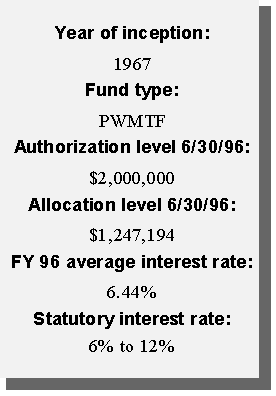
Program Description:
The purpose of this program is to provide a source of funding to improve and upgrade the business enterprises and guest accommodations in the park. Four private leaseholders in the park have used this program, receiving several loans since the program's inception. The loan period may not exceed 30 years, and the Board may set interest on the loans at no less than 6 percent and no more than 12 percent. By statute, the loan must not exceed 75 percent of the cost of the project, and a loan to a borrower cannot be made for more than $1 million.
Currently, one borrower is in default, and the Office of State Lands and Investments is in the process of foreclosing on the loans, which totaled almost $96,000. There is no loan loss reserve account authorized for this program, but loans must be secured by a mortgage or a lien upon all the property of the project. According to program managers, a 10-percent penalty is also assessed against late payments.
Recent Use:
In FY 92, 74 percent of the amount available for program loans was outstanding. That amount has decreased over the ensuing five years to 58 percent of the authorization in FY 96. Program managers said that no new loans have been made since FY 93. Principal payments made on existing loans are available to relend.
|
Policy Alternatives: The Legislature may wish to consider either eliminating this program or reducing the authorization. As a first step, it may be prudent to monitor the level of demand for this program as the current loans are paid down. Program administrators stated that they do not foresee an increase in demand for this program in the future because there are a finite number of leaseholders in the park, and they have made substantially all the improvements possible. However, there may be a need to retain at least part of the loan authorization to accommodate ongoing improvements in the park. |
Small Business Assistance Act Loan Program
In 1984, the Legislature authorized through W.S. 9-4-701(e) the State Treasurer to invest in the federally-guaranteed portion of U.S. Small Business Administration (SBA) and Farmer's Home Administration, business and industry loans (FmHA). By statute, the Treasurer may invest up to $35,000,000 in this loan program. The program provides fixed, reduced-interest rates on small business loans for the first five years to aid businesses through their startup phase. As established in statute, for the first five years of the loan the interest rate shall not be less than the yield of the five-year Treasury bond. After that time, the interest rate is adjusted to one and a half percent over the prime rate, net to the state.
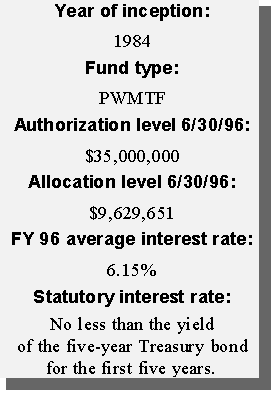
Program Description:
Loans providing reduced interest rates to borrowers originate with a local financial institution, and the Treasurer purchases the guaranteed portion of these loans. The Wyoming Industrial Development Corporation (WIDC) acts as the state's agent and loan servicer for this program. The SBA guarantees 90 percent of each loan it approves, while 75 percent of a loan offered through the FmHA is guaranteed.
To qualify for this loan program, the borrower must assure the creation of additional permanent jobs or preservation of existing permanent jobs. According to the WIDC, 71 jobs were created and 20 jobs were retained as a result of this program in 1996. Individual loan maturity dates vary, but do not run more than 20 years. The term of the loan is set based on the useful life of the asset financed. Proceeds can be used for new construction, construction of an addition or remodeling of an existing structure, purchase of new structures, or equipment. Proceeds may not be used for working capital, refinancing existing debt, or the purchase of an existing business.
Recent Use:
By statute, the program was originally slated to end in 1986, but the Legislature has extended the date several times. Currently, the program is authorized until December 1999. The Legislature amended statutes in 1991 to reduce the permanent funds allocated for this program from $50 million to $35 million. In the past five fiscal years, about 25 percent of the permanent fund authorization available has been invested in these loans. The funds represent revolving monies, so the principal returned is available to purchase other loans.
|
Policy Alternatives: The Legislature may wish to consider reducing the authorization for this loan program, since only 25 percent of the amount available has been used to purchase loans over the past five years. Restrictive lending terms may account, in part, for the modest loan volume of this program. Small business owners may be seeking loans for operating capital, rather than to create additional jobs. The program appears to experience greater use during rising interest rate periods, so interest rate forecasts should be considered when determining the appropriate level of authorization. |
Link Deposit Program
The Link Deposit program was established in 1986 under W.S. 9-4-832. It provided reduced rate loans to businesses, which were to use the funds to create or retain jobs in Wyoming.
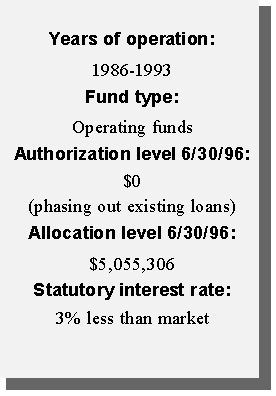
Program Description:
At its peak in 1990, the program was responsible for $138,658,127 in linked loans throughout the state. The "link" mechanism allowed the State Treasurer to deposit state funds with a participating bank in an amount equal to the principal of each loan. The state agreed to accept reduced interest rate earnings (three percent less than the market interest rate) on these deposits so the savings could be passed on to the borrower, for the purpose of creating and retaining jobs.
A 1991 program evaluation by the Legislative Service Office found that borrowers were nearly three times as likely to use the loans to retain jobs as to create new ones. In addition, 72 percent of the dollars were being used to refinance existing debt, not to start new businesses.
Recent Use:
Since the Legislature allowed the program to expire in 1993, no new loans have been made and the amount of state funds committed to existing loans has declined significantly. As of November 1996, there were 31 loans outstanding amounting to $5,055,306. The last loans will come due in 1998.
|
Policy Alternatives: The Link Deposit loan program is winding down, and will be completely phased out in 1998. In the future, if considering a proposal for a similar program, the Legislature may wish to consider establishing tighter controls to enhance accountability. For example, the Legislature could require more complete and standardized documentation of each loan made, regular auditing, and ongoing state-level evaluation of the program's overall performance results. |
Clean Coal Investment Program
Authorized in 1987 through W.S. 9-4-701(a)(iv)(C), the Clean Coal Investment Program allows the State Treasurer the opportunity to invest in the bonds of projects that enhance the value of and open new markets for Wyoming coal. The intent of the program is to assist Wyoming businesses that will use the state's resources, employ people within the state or otherwise add economic value to goods, services or resources within the state, and expand the gross state product.
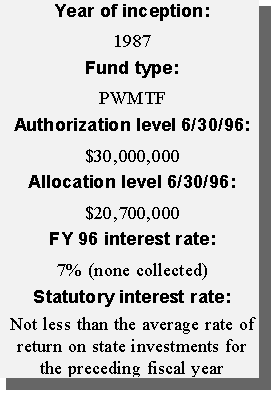
Program Description:
Three firms, WCRS, CarbonTec, and KFX, currently participate under this program. By statute, the State Treasurer shall ensure the complete protection of the PWMTF by requiring the pledging of either U.S. Treasury zero coupon bonds or a guaranteed investment contract. The duration of the investments cannot exceed 15 years. The interest rate on the investment shall not be less than the average rate of return on state investments for the preceding fiscal year. The interest rate for each project is 7 percent with a penalty interest rate of 10 percent. The State Treasurer has the authority to invest in bonds only after a favorable recommendation by at least five members on the Investment Fund Committee.Two of the three participants are currently in default and the third investment (KFX) underwent a financial restructuring. As a result of this restructure, the State forgave the interest and penalties in exchange for certain fees when a commercial processing plant is in operation and producing. To date, no fees have been received. As of March 31, 1997, WCRS owed $3,707,478 in interest and penalties. CarbonTec owed $625,737 in interest and penalties.
Recent Use:
The State Treasurer allotted the outstanding funds in the late 1980s. Since 1990, the Treasurer has not invested in any new enterprises. According to the State Treasurer, future allocations under this program are unlikely.|
Policy Alternatives: In light of the poor performance of the all three clean coal investments, the Legislature may wish to debate the merits of this program as a viable investment. Should the Legislature wish to continue this program rather than phasing it out, additional protections or guidelines might enhance the performance of future endeavors. Specifically, the Legislature could require tighter controls and a more thorough analysis of future projects. |
Wyoming Territorial Park
The Wyoming Territorial Park in Laramie is authorized in W.S. 36-8-1001 as a state park and historic site, managed by a non-profit corporation under a lease arrangement with the Wyoming Department of Commerce. The Wyoming Territorial Park Corporation (WTPC) is solely responsible for managing and financing the development and operation of the park and receives no ongoing funding support from the state.
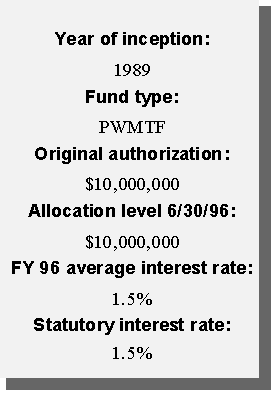
Program Description:
In 1989, the Legislature approved a 25-year loan of $10 million at 6 percent interest to the city of Laramie for the development of the park. The Legislature required the loan to be secured by the purchase of zero coupon bonds sufficient to guarantee repayment of the loan in full at maturity (2014). Prior to release of the loan funds, the voters of Albany County were required to approve a capital facility optional one-cent sales tax, $5 million of the proceeds of which would be used to pay interest on the debt.
The park has been operational since 1991, but initial projections of attendance and revenues did not materialize. As a result, a reduction in the interest rate was requested, and in 1994, the Legislature reduced the rate to 1.5 percent. In addition, the Legislature directed the Investment Fund Committee, prior to January 1, 2000, to review the interest rate and recommend any change deemed appropriate.
Recent Use:
The city is current on its annual interest payments of $150,000 and has set aside in escrow the revenue from its capital facilities tax to fulfill the city's interest obligation. If the Legislature were to raise the interest rate after January 1, 2000, any excess obligation would be the responsibility of the WTPC, not the city of Laramie. When the zero coupon bonds mature in 2014, the $10 million in principal will be returned to the PWMTF.
|
Policy Alternatives: The loan and the WTP project are complete, with principal and interest (at the current rate) guaranteed. In the future, if presented with a similar proposal, the Legislature may wish to consider requiring a rigorous, independent analysis of projected revenues. The Legislature could also require prior approval by an impartial board or commission, based on analysis of legislatively approved criteria for economic development and historical preservation projects. |
Industrial Development Bonds (1991)
Authorized in 1991 through W.S. 9-4-701(h), the Industrial Development Bond Program attempts to promote economic development in Wyoming. This program is the first of two industrial development bond programs the Legislature passed as designated investment programs. Unlike the second program, the amount of funds available here is dependent upon the number of employees retained or new full-time employment positions created.
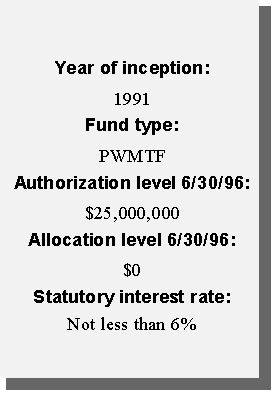
Program Description:
The statute authorizes the State Treasurer to invest permanent funds in industrial development bonds issued by municipalities or counties. The program is explicitly designed to finance the cost of constructing a facility for manufacturing or processing; for commercial or business enterprises; or for reconstructing, remodeling, modernizing or expanding an existing facility which will add economic value to goods, services or resources within Wyoming. In addition to the Treasurer's oversight, any project must have written approval of the Governor and the Attorney General. The owner is required to have an equity investment of at least 25 percent in the project. Further, at least 50 percent of the bonds sold to finance the project are purchased by investors other than public entities of the state. This program is similar to the other industrial development bond program authorized for $10 million, but each has substantially different criteria, credit terms, and oversight features.Recent Use:
Although a number of interested parties considered the program, no funds are currently outstanding. The total amount of the bonds purchased under this statute shall be subtracted from the total authorization and the State Treasurer may not purchase that dollar amount again, even though the bonds have been retired, redeemed, or refunded. Therefore, the authorization is not revolving, but one-time use, funds.
|
Policy Alternatives: The Legislature could reconsider the merits of this program. In light of the fact that the program has been available for more than six years and never been used, coupled with the fact that no serious proposals are currently underway, the state could benefit from a reconsideration of this program. If the Legislature chooses to continue it, it could be combined with the other industrial development bond program under generic guidelines with consistent credit terms, criteria, and oversight mechanisms. |
Industrial Development Bonds (1995)
This Industrial Development Bond Program allows the State Treasurer to invest in bonds issued by municipalities or counties for the purpose of constructing or reconstructing an agricultural products processing facility. As the second of two Industrial Development Bond programs the Legislature has designated, this program appears to be more specific than the earlier program in terms of qualifying projects.
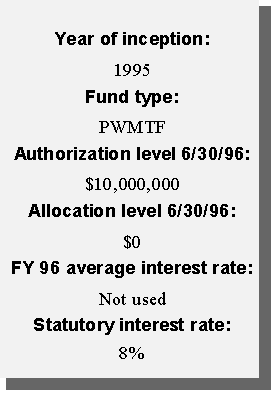
Program Description:
Authorized in 1995 through W.S. 9-4-701(o), the purpose of the program is to promote economic development within Wyoming. The State Treasurer is ultimately responsible for investing in the bonds under this program. Statute specifies an interest rate of 8 percent on all bonds. A successful applicant must gain the approval of the Governor and Attorney General. Further guidelines require a contract with a Wyoming industrial development corporation for review and recommendation.Although the program was specifically proposed for one industry, agricultural processing, it is general enough to permit any entity within the industry that qualifies and provides new full-time employment to participate. This program is similar to the 1991 Industrial Development Bond Program authorized for $25 million, but the two do have substantially different criteria, credit terms, and oversight features. For example, this industrial development bond program does not require approval of the Investment Fund Committee.
Recent Use:
The entire amount of the authorization is available for investment at this time. Although there was initial interest in the program during legislative consideration, these plans have not developed. Similar to the other industrial development bond program, the authorization is not revolving. The $10 million authorization is available for one-time use only.
|
Policy Alternatives: The Legislature could reconsider the merits of this program. Although the program authorization is relatively new, there are no serious proposals underway. If the Legislature chooses to continue this program, they could consider combining this program with the other industrial development bond program under generic guidelines with consistent credit terms, criteria, and oversight mechanisms. |
Chapter 3: Funds Allocated to LDIs Earn Less-Than-Market Returns
LDIs result in lower-than-market earnings in two distinct ways. First, the funds allocated to specific projects and programs are earning less than they could if invested in other ways. This chapter explains the impact of allocated funds on overall LDI earnings. Second, interest earned on the funds that are authorized, but not allocated, is also less-than-market. In Chapter 4, we explain how unobligated funds contribute further to reduced earnings.
Allocated Funds Earn Lower Returns
. Earnings on LDI allocations are lower than returns on other funds managed strictly for investment purposes. We define allocated funds as authorized funds which are actually put to use for LDIs. Over the past five years, reduced earnings amounted to subsidies as high as $6.25 million per year. Earnings were lower than they might have been due to the Legislature's willingness to approve LDIs that forgo market return in exchange for other potential economic and social benefits. There has been no attempt to measure such ancillary benefits.The Legislature can minimize future reductions in earnings by careful consideration of both the costs and the benefits of proposed LDIs. An increased awareness and consideration of the financial impacts of LDIs could result in an investment direction that enhances financial returns.
Not All State Funds Have a Clear Investment Objective
PWMTF
. Since 1974 when Wyoming established the PWMTF, statutes indicate a legislative readiness to set aside an increasingly large share of the state's permanent funds for specific investments. For example, 20 of the 26 LDIs use PWMTF monies, with authorizations amounting to $953 million. However, the Legislature has not been guided in making these decisions by an overall plan or set of investment objectives.In the Constitution and statutes, there is neither an explicit requirement nor implicit suggestion that PWMTF investments should maximize return. Consequently, in the absence of a clearly stated, comprehensive investment philosophy for the PWMTF, the fund exists without a specific goal, or a constituency dedicated to maximizing its returns.
By contrast, the state of Alaska determined early that it was unnecessary, as well as unwise, to try to design a permanent fund to do all things. Consultant input and public hearings resulted in agreement on a number of principles after the passage of a proposed constitutional amendment in 1976 to create a permanent fund:
Operating Funds.
Other contributors to reduced earnings are those LDIs which are authorized from operating funds. The TDOA Program and the Link Deposit Program do not require investment of permanent funds, but rather, use operating funds.For accounting and investment purposes, the State Treasurer has instituted an agency pool. The "State Agency Pool" represents the cash balance of all funds and accounts for which specific investments have not been made. It also includes portions of comingled funds from the PLF and PWMTF.
In regard to LDIs, this accounting pool is the source of the operating funds from which TDOAs and link deposits originate. At the end of FY 96, these two programs accounted for $93 million in LDI allocations. When compared to the estimated realized return of the State Agency Pool, they contribute substantially to reduced earnings.
PLF.
Four LDIs are linked to the Permanent Land Fund (PLF), primarily the Common School Account (CSA) within the PLF. These LDIs do not contribute substantially to any forgone interest earnings, since the CSA's main objective is to produce the maximum long-term investment return for a defined beneficiary. Thus, the State Treasurer has chosen not to invest in LDIs that conflict with this objective.LDI Performance Compares Unfavorably to Other State Investments
Comparing the rates of return realized by LDIs with the performance of similar state funds shows the magnitude of the forgone earnings. Since the LDIs are diverse in purpose, investment mechanism used, and fund of origination, there appears to be no perfect comparator or established benchmark.
Consequently, we offer several different comparisons in this section, using the best available information, to determine the returns on the allocated portion of the authorization for each LDI. This analysis does not attempt to quantify the benefit of any gains from social investing or economic development. Our methodology is described in Appendix A.
Comparison # 1 -- Fund Specific.
Our analysis of recent earnings shows that the allocated portion of all LDIs earned proportionately less than did the specific fund of origin of each LDI. The estimated forgone earnings for all LDIs range from $6.25 million in FY 92 to $800,000 in FY 96. We compared the estimated return of each LDI with the estimated return of the fund from which the specific LDI originated. This method provides a realistic comparison, since it measures what the funds allocated to LDIs could have actually earned if the Legislature had not directed the investment.Impact of Farm Loans.
We noted, however, that inclusion of farm loans in the figures cited above tends to distort the overall impact. Over the past five fiscal years, farm loans constituted 35 to 40 percent of the total allocated funds for LDIs, and they consistently performed above the average return on other PWMTF investments. Thus, in our analysis, they tend to "subsidize" other LDIs by compensating for some of the poor performers.For example, the statutory interest rate for the Wyoming Territorial Park is 1.5 percent, but the effect of this low rate is less noticeable because it accounted for only 2.3 percent of the total allocated LDI funds in FY 96. Other LDIs also have low interest rates but collectively, their low earnings are obscured by the performance of farm loans.
For the purpose of additional analysis, we excluded farm loans from our calculations. Then, a clearer picture of the performance of 60 percent of LDI-allocated dollars emerged. Figure 3 illustrates estimated reduced earnings for the past five fiscal years. They range from $7.6 million to $3.8 million each year.
Figure 3: Forgone Earnings of Allocated LDIs Excluding Farm Loans
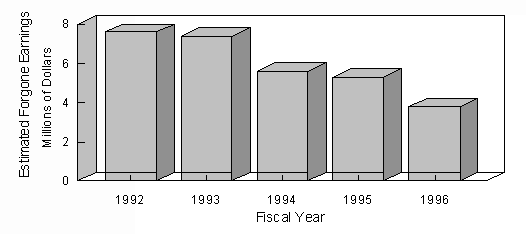
Source: LSO analysis of State Treasurer's data.
Explanation of Downward Trend
. Two factors appear to contribute to the obvious downward trend in forgone earnings. First, the outstanding balance of link deposits declined substantially during these five years. In FY 92, link deposits accounted for $104 million of the total funds allocated for LDIs, but as of June 30, 1996, only $5.4 million was outstanding. During that time period, the realized interest rates for link deposits ranged from 3.01 percent to 4.24 percent. These rates are significantly less than the return on the State Agency Pool (its source of funds) for the same period.Second, the realized yields on the PWMTF and the Agency Pool have steadily declined over the analysis period. For example, the realized yield of the PWMTF steadily declined from 7.49 percent in FY 92 to 6.74 percent in FY 96. Over the same time period, the realized yield of the Agency Pool decreased from 7.36 percent to 6.16, despite a small increase in FY 93. This reduction in interest rates tends to further diminish the quantifiable impact on poorly performing LDIs.
Comparison # 2 -- PWMTF II.
In 1994, the Treasurer segregated a portion of the PWMTF into a separate account, PWMTF II. This investment pool of $250 million is an unrestricted pool to be invested for the most beneficial return. To use PWMTF II as a comparator, we included only those LDIs authorized from the PWMTF, including farm loans. Therefore, this analysis excludes LDIs allocated from the PLF and operating funds. This allowed us to compare the performance of LDIs originating within the PWMTF to the estimated returns of the PWMTF II.Using this method, we estimate that, had allocated funds been invested in PWMTF II, $3.9 million more might have been earned in FY 95, and $2.2 million more in FY 96. These results would be even more dramatic if farm loans were excluded from the analysis.
Additional Comparisons.
The returns of the allocated portion of LDIs could also be compared with the returns of the state permanent funds invested by external managers or the returns of the Wyoming Retirement System (WRS).In addition to other factors, since the funds invested with external investment managers have no liquidity restrictions or other pending obligations, those funds generally produce a higher rate of return than state funds invested in-house. For the past five fiscal years, the realized yield for the external investment managers ranged from 6.35 to 10.71 percent. Therefore, an analysis with this more aggressive comparator results in a larger divergence from the rates of return on LDIs, and thus greater lost earnings.
Comparing the returns of the LDI allocations with the returns of the WRS may not be appropriate retrospectively because it has different investment restrictions. The recent passage of a constitutional amendment and statutory language allow up to 35 percent of the book value of total investments of permanent funds to be invested in specified securities. Therefore, this comparison may be valid for prospective analysis of future forgone earnings.
WRS returns ranged from -2.8 to 25.9 percent over the past five fiscal years. Since WRS returns are volatile, a comparison with the returns of LDIs would not, in every instance, result in forgone earnings. However, on balance, the magnitude of the lost earnings with this comparator is much larger than with the previous comparisons.
Other Funds Maximize Returns
We compared Wyoming's approach with two other states which have significant permanent funds to invest, Montana and Alaska, and found that each has defined policies for participating in targeted investing. In Montana, state law authorizes its investment board to invest a maximum of 25 percent of the Permanent Coal Tax Trust to increase employment and business opportunities. In Alaska, one of the basic principles of the Permanent Fund is that investments should be income-producing at market rates of return.
We reviewed investment policies of the WRS and selected states' pension funds which invest in ETIs. We found they do so when the investment results in at least a market rate of return.
Additionally, unlike the PWMTF, the CSA has an identifiable set of beneficiaries for whom the trust is managed for the maximum and exclusive benefit. As a result, the CSA investments do not generally generate lower returns through the promotion of economic development or other social investments.
Chapter 4: Unobligated LDI Funds Also Earn Less-Than-Market Returns
Chapter 3 described how allocated LDI funds reduce investment returns. This chapter goes on to describe how funds authorized for LDIs, but unobligated for those particular purposes, further contribute to lower overall returns. Unobligated LDI funds constitute the difference between the statutorily-authorized level of each LDI and the amount of funds actively at work for the intended purpose.
Our analysis shows that in the past five years, the state earned up to 3.37 percent less on the unobligated portion of LDIs than on state funds invested without legislative obligations, depending on the year and specific comparator. The fact that unobligated LDI funds could potentially be allocated appears to contribute to diminished returns.
We considered the entire authorizations for the Student Loan Stand-By Program, the School District Bond Guarantee Program, and the Local Government Bond Guarantee Program, to be unobligated. Two of these programs, Student Loan Stand-By Program and School District Bond Guarantee Program, have commitments in place for portions of their authorizations. However, no funds are actually outstanding. The State Treasurer is responsible for investing the entire authorization for these programs, which both have some liquidity considerations.
Figure 4 illustrates the level of allocated and unobligated funds for all LDIs over the past five fiscal years. Total unobligated LDI funds increased from $459 million in FY 92 to $726 million in FY 96.
Figure 4: LDI Authorizations: Allocated and Unobligated Funds
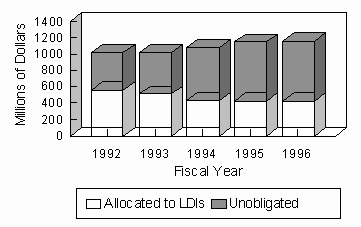
Source: LSO analysis of State Treasurer's data.
Cash Management Procedures Limit Returns on Unobligated LDI Funds
Unobligated portions of LDIs produce lower returns than otherwise possible because potential obligations restrict their availability for investment. Even though unobligated funds are not currently being used for the public purposes for which they were intended, the prospect exists that they might be called upon. Therefore, the State Treasurer keeps a portion of the unobligated amounts in the State Agency Pool.
State Agency Pool.
At the end of FY 96, the State Agency Pool had a balance of $1.3 billion, approximately $375 million of which came from the PWMTF. The Treasurer manages this pool to meet the state's immediate operating needs, which include dispersals for LDI programs and projects. Fully 45 percent of PWMTF that is neither obligated to LDI programs and projects, nor invested in PWMTF II, is in this pool. The Treasurer has invested approximately $300 million of the State Agency Pool in short term investments to meet the cash flow needs of the state, and the remainder in longer-term investments.The State Treasurer makes decisions to keep portions of the PWMTF in the State Agency Pool for reasons in addition to dispersals to LDI programs and projects. These include the existence, currently, of a flattened yield curve (i.e., the difference in yields between shorter and longer duration investments is minimal), rising interest rates, and the need to have cash available to invest in equities as directed by the Legislature under the new constitutional authority.
No formal cash flow analysis procedures are in place for LDIs to help the State Treasurer determine how much liquidity is appropriate for these programs and projects. The Treasurer believes that informal but constant monitoring and communication with program officials, and a knowledge of historical trends, provide the information needed to keep an appropriate amount of funds liquid. On the basis of this informal system, the State Treasurer "ladders" investments within the entire State Agency Pool so that maturities meet expected cash needs.
Unrestricted Investments Perform Better Than Unobligated LDI Funds
The returns on the State Treasurer's unrestricted investments, or those with no liquidity restrictions or pending obligations, generally outperform the returns on unobligated LDI funds. Figure 5 represents the estimated returns of the unobligated portions of PWMTF LDIs, compared to the returns of all state funds managed by external managers. For the past five years, the difference in these two yields ranges from a low of -0.42 percent to a high of 3.4 percent. Appendix A further outlines our approach and methodology for this analysis.
Figure 5: Realized Yields: Unobligated PWMTF LDIs vs. External Managers
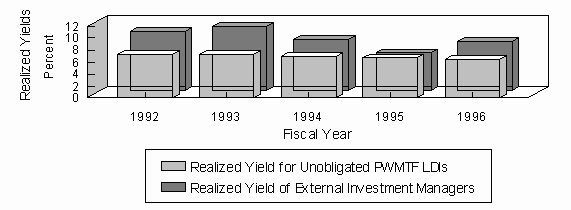
Source: LSO analysis of State Treasurer's data.
Figure 6 compares the estimated realized yields on unobligated portions of PWMTF LDIs with the estimated realized yields on PWMTF II, for the two years of its existence. The difference in yields for each of these years amounted to roughly one percent. In both illustrations, comparators adhere to similar state investment restrictions, but are not inhibited by obligations such as LDIs.
Figure 6: Realized Yields : Unobligated PWMTF LDIs vs. PWMTF II
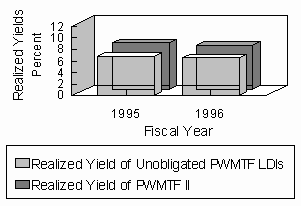
Source: LSO analysis of State Treasurer's data.
Reducing Unobligated Funds Enhances Investment Returns
Considerable opportunity costs are associated with maintaining authorized, but unobligated, LDI funds. Had some reductions and eliminations in excess authorization levels been made, the state could have earned up to $2.9 million in additional earnings in FY 95, and $2.4 million in FY 96. These amounts could have been earned if some of the funds authorized for LDIs had been invested in PWMTF II. Specifically, according to our analysis, $267 million in reductions of the unobligated portion of LDIs would have generated these additional earnings.
Example of a Reduction and Elimination Process.
To estimate the additional earnings that could potentially result from reducing excess unobligated funds, we established a process for making reduction and elimination decisions that would be based on reasonable assumptions. We analyzed LDI programs and projects using the subjective and objective criteria listed below:In estimating potential increased earnings, we also made the following assumptions:
Applying these criteria, we made hypothetical LDI reductions and eliminations totaling nearly $267 million. For the reductions we made, we applied a constant reduction factor of 50 percent of the existing authorizations:
For purposes of this analytical exercise, we selected the following programs for possible elimination. Each meets all of our criteria and, in particular, has either never been used, or the use has steadily declined over the last five fiscal years:
These reductions and eliminations are not intended as specific recommendations, since under current investment practices, the performance of the unobligated portion of each LDI is indeterminable. Rather, the exercise presents certain reductions and eliminations that would achieve the purpose of reducing unobligated portions of LDIs. We assume the Legislature would have the benefit of more detailed knowledge of each program before it would consider taking such specific actions.
The Legislature Might Consider Options for Management of Unobligated Funds
Increased earnings are possible within the category of unobligated LDI funds. Achieving just one percent more per year on $200 million results in an additional $2 million in interest revenue. Several alternatives and methods may achieve the same or similar results. The alternatives have both merits and shortcomings, as summarized below.
Reductions and Eliminations.
Our analysis suggests more than $250 million of LDI authorizations could be eliminated. The Legislature may wish to consider only some of the illustrated reductions, or perhaps a different set of reductions based on different criteria. Regardless of which LDIs are reduced, it appears earnings can be improved.There are, however, potential drawbacks with this alternative. With any reduction or elimination, the state loses the opportunity to use the program and forgoes the potential benefits that could be provided. Second, even if the Legislature chooses to make such reductions, it might at the same time establish new programs. Such programs would reduce the Treasurer's ability to invest funds in PWMTF II with reasonable security, thus defeating the purpose.
Cap the Total Allocation Level.
Capping the total allocation level, while keeping total LDI authorizations intact, would achieve similar results. This method could be applied in various ways. For example, the Legislature could cap the maximum allocation level at $250 million below the current authorization. Alternatively, the Legislature could cap the total allocated amount of LDIs at a specified percentage of the PWMTF.Another, two-tiered "cap" approach, might also be implemented. Using this method, each LDI would be capped at a specified amount above its current allocation level (e.g., $5 million), or at an amount appropriate to anticipated use. Further, the use of the unobligated portions of the LDIs would be capped at a specified amount (e.g., $100 million), and that amount pooled for allocation to whichever LDIs need it to meet demands. The State Loan and Investment Board could make pool allocation decisions among LDIs and report upon them annually to the Legislature.
The advantages to the "cap" approaches would be that they offer flexibility to accommodate LDI growth, yet limit the amount of funds the State Treasurer must manage under the specter of possible allocation to one or more of the LDIs. Reducing or eliminating LDI authorizations would enhance results obtained from all three of these "cap" approaches.
There are at least four caveats to the "cap" approaches. First, the Legislature would need to commit to the established cap(s), as increases would defeat its purpose. Second, although these approaches would keep all programs operational, it might provoke competition for funds between LDIs if the total allocated level approaches the cap. Third, the large water projects which will soon be under construction will use up a significant portion of the currently unobligated funds.
Fourth, the Legislature should carefully consider the amounts committed and uncommitted through the bond and student loan guarantee programs when implementing any cap. The 1997 legislation increased both the Direct Student Loan Program and the Student Loan Stand-By Program by a cumulative $60 million, an increase that is not included in our analysis.
Improve Cash Forecasting and Management Techniques.
A formal cash management system could aid the State Treasurer in making investment decisions that increase investment earnings. Recently, as part of the asset allocation analysis, the State Loan and Investment Board requested both the State Treasurer and State Auditor to prepare a cash flow analysis.It is important that this effort include LDIs to determine, as precisely as possible, their cash needs so that earnings are maximized. For example, program officials indicated that projections on the use of farm loans (the LDI with the largest amount unobligated) could be made, such that there would be small risk of needing to sell long-term securities at a loss to meet demand. Other LDIs may also lend themselves to more precise projections. With such projections, those involved in LDI administration could budget for anticipated needs on an annual basis.
The incentive for developing a cash management process is the identification of funds available for longer-term investments. With an accurate forecast, an investment officer can take advantage of higher returning investments. Developing such a process forces officials to think through their present investment practices and explore alternatives.
Nevertheless, even with improved cash projections, other factors such as the need to protect against interest rate risk and the need to have funds available for external equity managers, may call for additional liquidity. Furthermore, if program administrators adopt this option, the State Treasurer may still need to accommodate potential new LDIs. As a result, the state might not realize the same $2 million benefit in increased returns under this option.
Maintain Existing Approach.
The Legislature may not wish to take any action. Leaving the authorization and allocation levels at their current size maintains the option to use any of the existing programs to their full capacities. This enables the state to realize future benefits that result from the use of LDI programs. However, the Legislature should recognize this option will likely continue to result in reduced investment returns.
Chapter 5: LDIs Should Complement Other State Efforts to Accomplish the Same Public Purposes
Some LDI programs and projects have competed with rather than complemented other state programs, including other LDIs, intended to accomplish similar public purposes. Further, in some instances, they actually counter or are countered by those efforts. Such a lack of coordination among alternatives intended for the same public purposes can undermine the effectiveness of the state's use of resources.
In addition, some LDIs appear to be ineffective in helping the state meet intended public purposes because they are targeted to meet specific circumstances and conditions. Over time and as conditions change, these programs have fallen into disuse. Finally, we found the technical aspects of some programs diminish their usefulness.
Some LDIs Compete with Other State Efforts to Finance Local Government Infrastructure
The Local Government Bond Guarantee and Joint Powers Act Loan programs, and direct legislative loans for water treatment projects, potentially compete with one another as financing alternatives for such projects. If it were operational, the bond guarantee program would enable local governments to issue bonds at optimal interest rates to pay for infrastructure needs, such as water treatment plants. These rates would likely be lower than the rates currently charged by both the Water Development Commission and the State Loan and Investment Board for intergovernmental loans (7.25 percent), and the rate at which the Legislature made its most recent direct loans (8 percent).
However, bonding at any rate would not provide the interest-free years and deferred payments that make direct legislative loans especially attractive to local governments. The opportunity to obtain a legislative loan or federal mineral royalty grant may dissuade local governments from making use of the bond guarantee program.
Local governments may be choosing not to use another LDI, the Joint Powers Act Loan Program, for similar reasons, since it also does not offer the interest and payment deferral option. In addition, this program's loan capacity would not have been adequate to cover the two latest projects financed with direct legislative loans (Natrona County Regional and Green River/Rock Springs Treatment Plants), especially when combined with applications from other local governments. Even if it had, the Joint Powers Act Loan Program provisions such as a one-point origination fee and a maximum 40-year term make these loans less favorable than those received by project sponsors who went directly to the Legislature.
Some Programs Have Inhibiting Criteria
In developing responses to specific needs, the Legislature has created some programs that have limited applicability. For example, the two LDIs authorizing the state to purchase industrial development bonds do not provide a revolving source of financing. Further, the Legislature has set criteria that require developers seeking these bonds to be substantially financed through personal equity and other investors before approaching the state. While these and other criteria protect the state's assets, they may also inhibit the bonds' effectiveness as economic development tools for the state.
The Small Business Assistance Act Loan Program, another LDI targeted at economic development, has technical provisions that apparently inhibit its usefulness for intended beneficiaries. Although the program offers benefits not otherwise available to small businesses, relatively few have used the loans: the state's investment approximates only a quarter of the program's capacity. Economic development officials note that the program's criteria, which prohibit use of loan proceeds for operating capital, may be too restrictive to help small business owners.
Offering capital for operating costs may be more appealing to small business owners than providing capital for business start-up and expansion costs. Other public investors take this approach. For example, Montana's program covers operating capital, inventory, and equipment, but it ties interest rate reductions to job creation. Even though there is little use of the rate reduction feature, Montana has more than $40 million invested in this program. In Wyoming, the state retirement system currently invests in the guaranteed portions of federal Small Business Administration (SBA) loans that do cover operating capital, but only at a market rate. Despite its higher interest rate, the retirement system's investment in SBA guaranteed loans is approximately the same as the state's.
Changes in Economic Conditions Affect the Need and Purpose of Some LDIs.
Since LDI programs appear designed to finance some public purpose at subsidized rates compared to those available in the private sector, the use of LDI programs could potentially increase with an increase in interest rates. For example, program officials noted that loan volume in the state's Small Business Assistance Act Loan Program increases when interest rates rise. Then, borrowers use the opportunity to obtain lower initial rates and lock in fixed rates for the loan durations.
Similarly, the LDI program that authorizes the Treasurer to purchase pools of home mortgages that net the state ten percent is attractive in times of high market rates. In lower market rate conditions, however, there is little likelihood the state will have an opportunity to purchase such mortgages.
The following discussion of the two largest LDIs illustrates how economic conditions affect the purposes of these investments. Together, the state had more than $255 million allocated to the Farm Loan and TDOA programs in FY 96.
Farm Loan Program:
The Farm Loan Program is an example of a program that has evolved over time to meet changing economic conditions. The State Land and Farm Loan Office director noted that these loans meet several objectives, including ensuring the availability of adequate agriculture credit; of credit at stable rates; and of credit equally available for agricultural producers throughout the state. All of these objectives, he noted, are not always needed, so perhaps a flexible objective is appropriate.Time Deposit, Open Account Program:
The state's TDOA Program was created for a purpose that economic conditions have rendered obsolete. When the program was established in 1907, the state needed secure banks in which to deposit its funds. In the 90 intervening years, the need for physical security has diminished, and this program's purpose has evolved without statutory clarification.Currently, that purpose is understood to be providing Wyoming banks with a source of stable, reliable, and rationally-priced money. Banks use this added liquidity to make loans and meet customer withdrawal demands, and the state deposits a portion of its operating money in this program rather than putting it in other short-term investments. However, the state must maintain additional liquidity because the TDOA investment is not really available for operating cash, which is the presumed purpose of short-term investments.
Programs Created Ad Hoc May Ineffectively Use State Resources
The sometimes counter-productive and restrictive natures of certain LDI programs occurred as the Legislature created them on an ad hoc basis to address specific needs. Ideally, they might have been designed as parts of comprehensive state efforts to address broad public policy areas. Because they were designed to meet perceived public needs, the programs all have merit, but they also have costs and other limitations.
These costs are primarily indirect, or those of lost opportunities. LDI programs that counter or undermine one another or other state programs result in the under-use of some, and an increased demand for those with more favorable or current terms. In addition, as previously discussed, several LDI programs have great unused funding capacity, for which increased earnings would be possible if the funds were available for longer-term investment. Finally, committing state funds to programs that are too narrowly conceived or inappropriate for current economic conditions leaves them unavailable for future uses that policymakers may agree are beneficial for the state.
Other Models Exist for Accomplishing Public Purposes
Other states have taken more comprehensive approaches to meet similar public purposes. For example, rather than turning to its Permanent Fund, Alaska has built institutions to finance such public purposes as industrial development, housing, and local government infrastructure. These include an Industrial Development and Export Authority, a Housing Finance Corporation, and a Municipal Bond Bank Authority.
Through its bond bank authority, Alaska sells its "A" rated bonds on the national market and uses the proceeds to purchase the bonds of Alaskan municipalities. In this way, the state provides local governments with funds for capital construction projects at lower interest rates than they could bond on their own. The bond bank uses the principal and interest paid by the municipalities to repay its debt to its bondholders.
By providing an opportunity for local governments to lower the cost of their debt, this approach is similar in concept to Wyoming's Local Government Bond Guarantee Program. Wyoming's program, however, has not been made operational, largely because local governments have not expressed interest in this approach. State and local officials we interviewed noted that bonding entails complexities that make it unattractive to local governments.
The bond bank approach assists governmental entities that may lack the resources or investor familiarity to bond on the national market. Although never used, Wyoming has a bonding authority that is similar to the bond bank concept. This authority, W.S. 9-4-604(b), enables the State Loan and Investment Board to issue up to $60 million in bonds, the proceeds of which can be loaned or granted to local governments. The federal mineral royalties and coal lease bonus payments that the Legislature currently allocates to the local government capital construction fund would, by this statute, be used to repay these bonds.
According to several state officials, however, local governments would object to the state's use of this authority, as they prefer to receive those revenues directly as grants for their capital projects. Financing local government infrastructure in this manner, however, may enable the state to meet more needs than it could through direct grants.
Some States Use Authorities and Private Corporations to Address Public Purposes
Colorado created an authority to fund municipal water projects similar to those for which local governments in Wyoming have sought direct legislative loans. Similar to the Alaska bond bank, this authority issues bonds for pools of local government infrastructure projects, and also makes direct loans. The authority's bonds receive a AA rating based on the strength of its reserves. Colorado established these reserves using federal capitalization grants accompanying the Clean Water Act, along with the required 20 percent state match. The authority uses reserve earnings to further subsidize the interest rates local governments pay on their debt.
To provide the flexibility to meet economic development needs, public investors in Texas created a private investment company. The Texas Growth Fund manages a pooled fund from state public pensions and endowments that have elected to make investments that foster business expansion. By using the private company, these investors are able to customize financing and keep confidential proprietary information, even though public funds are the source of the investment capital. Because these investments belong to endowments and pensions, they must make a competitive rate of return, as well as encourage economic development. Hence, a critical aspect of this approach is hiring equity specialists with the expertise necessary to ensure that the fund meets these goals.
Montana Divided its Permanent Fund to Fund Local Government Infrastructure
Montana has designated a portion of its Permanent Coal Tax Trust to finance local government infrastructure. In 1993, the Montana Legislature divided the state's permanent fund into subfunds. The Legislature appropriates the investment earnings from one of these subfunds for local government infrastructure projects. The state established this subfund with a $10 million transfer from the Trust, and augments it with one-half of the coal severance tax earmarked for the Trust.
Wyoming Has Created Some Innovative Funding Mechanisms
Wyoming has also created some innovative approaches to funding capital construction. Since 1989, the state has used the authority in W.S. 9-4-605(b) to issue bonds for state capital projects. With this authority, the State Loan and Investment Board has issued revenue bonds backed by the federal mineral royalty distributions earmarked for the School Foundation Program. By this statute, the Board can issue bonds only if the Legislature has made appropriations for the capital construction costs. These appropriations are deposited into the Common School Account and invested so that annual returns equal or exceed the money diverted to cover the debt service. Thus, when the state repays the bonds, the Common School Account retains the original appropriation for future earnings.
By using this authorization, the state used two of its financial strengths as capital financing tools. These strengths, the federal mineral revenue resource and the sizable state reserves, enabled the state to issue AA- rated revenue bonds to fund infrastructure while investing its own money for current and future returns. The debt obligation created is clearly limited to the pledged revenue stream, and thus is not a general obligation debt to the state. These two financial strengths similarly leverage the state's capacity to finance government infrastructure through the school district and (potential) local government bond guarantee programs.
Another innovative financing approach taken by the state was the creation of a permanent source of funding for water pollution control needs. Using federal capitalization grants accompanying the Clean Water Act and the required 20 percent state match, the state created a revolving loan fund (SRF). Currently, the SRF has a balance of approximately $12 million available to local governments in reduced-rate loans for projects such as waste water treatment plants, storm water treatment, and non-point source pollution projects. Additional amounts will be available as current borrowers repay their loans.
The state currently has the opportunity to create another SRF with federal capitalization grants authorized as part of the 1996 Amendments to the Safe Drinking Water Act and a 20 percent state match. Federal guidelines allow these funds to be used for loans and loan guarantees, or as a source of reserve and security for leveraged loans. This SRF could be set up as a permanent source of funds to protect and treat drinking water sources.
The Legislature Should Consider More Effective and Innovative Ways To Use State Resources
Through its designation of state fund investments, the Legislature has demonstrated a commitment to using state funds for the benefit of its residents, whether by providing them treated water at a reasonable cost, or by guaranteeing loan programs that help cover college costs. In order to continue making such quality-of-life contributions as well as meet other state needs, however, the Legislature may wish to consider how it can better leverage its resources to do more.
Some efforts have already begun to improve the coordination of state resources. The State Loan and Investment Board has initiated a plan to coordinate the distribution of state funds for local government infrastructure. Local governments will be able to do "one-stop" financing for their infrastructure needs, with state officials providing assistance in developing funding packages using all available state resources, including Abandoned Mine Land grants, federal mineral royalty grants, Joint Powers Act loans, and the existing Clean Water Act SRF.
This is an important step because local government infrastructure needs are predicted to increase as facilities built during the "boom" years all start to deteriorate at the same time. The apparent trend of decreasing federal mineral royalties could add to the strain. The Legislature can support this coordination effort by assuring that any direct loans it makes complement a systematic approach, and perhaps by formalizing the coordination process in statute.
Financing Options Include Bonding
The Legislature can also support infrastructure financing efforts by enhancing the options available. One way would be to review existing authorities and determine if some, such as the bonding options, can be used more effectively and creatively. In the course of our research, however, we repeatedly heard that Wyoming is a "pay-as-you-go" state, which traditionally chooses to avoid debt. Therefore, the Legislature first needs to assess the strength of that position, and whether economic times have changed such that it makes sense to gradually revise that stance.
Further, the Legislature could consider opportunities to make its federal mineral royalty revenue stream and its strong reserves work to greater advantage as tools to finance government infrastructure. It has done this already by creating bonding authority to finance state capital needs and by guaranteeing school district bonds. The potential exists for more impact through the guarantee program for local governments. Another possibility would be to issue revenue bonds rather than direct loans for water treatment plants, or similar projects, and divert federal mineral royalties for the debt service. This approach would keep more of the PWMTF invested for maximum returns.
The state faces other opportunities with infrastructure financing. The new revolving fund potential for water treatment gives the state flexibility to design the program so that it can best meet projected needs. If potential use appears substantial, program designers might consider using federal capitalization funds and state match as leverage to bond, rather than simply as revolving loan funds. Further, as one state official noted, it may be worth considering new ways to use federal mineral royalties for local infrastructure, such as a revolving loan fund, to preserve some of that diminishing and finite state resource for the future.
In other public purpose areas, a recently commissioned study to determine the state's economic development needs may recommend innovative ways for the state to foster business expansion without jeopardizing the permanent fund income. Already, the state has taken an innovative step by creating the Workforce Development Training Fund to put existing revenues to work in aiding economic development. Finally, the State Loan and Investment Board's ongoing efforts to determine an asset allocation strategy may unveil opportunities to better use TDOA short-term investments so that they meet the liquidity needs of both state banks and the state itself.
Chapter 6: A More Formal Process Could Enhance Legislative Oversight for LDIs
The Legislature does not have a systematic way to evaluate potential LDIs, or a mechanism to periodically review existing LDIs. As a result, the Legislature is not positioned to compare the merits of one investment proposal against another, and has not been able to build an inclusive perspective about the cumulative impact that LDIs have on the state's revenue picture.
According to the Governmental Accounting Standards Board (GASB), it is important to develop performance information that guides decision making. Information is needed to allocate resources to programs, to evaluate the results and determine if they are making progress in achieving established goals and objectives, and to modify programs to enhance performance.
Standards Have Not Been Developed to Evaluate Proposed LDIs
The Legislature does not have a formal system or process for evaluating proposed LDIs, whether they are projects, such as the Wyoming Territorial Park, or programs, such as the Joint Powers Act Loan program. In addition, once approved, the provisions guiding LDIs are not uniform in requiring performance evaluation and reporting.
Method to Evaluate Investments.
The Legislature has not established criteria to assist in evaluating whether to authorize proposed investments for specific public policy purposes. It does not have policies regarding when it will designate funds for these types of investments or standards for establishing goals and outcomes for these investments.The Legislature relies on its fiscal note process to provide evaluation of a potential investment. However, fiscal notes have not been a consistently reliable predictor of opportunity costs for these investments. We examined the original bills for most of the 26 LDIs included in this evaluation, and found that about 25 percent of the proposals pre-dated LSO's practice of preparing fiscal notes. On another 20 percent, it was noted that there had been insufficient time to prepare a fiscal note. Comparing several fiscal notes that the Treasurer's Office completed, we noted that a consistent process for presenting the information was not used. Some appeared to over-state anticipated costs, while others minimized them.
Terms Established for Investments.
As it established individual LDIs, the Legislature did not consistently require evaluation and reporting on their performance. It may be that the Legislature has not considered these investments as a category, with similarities that would call for uniformity in monitoring and reporting on performance.Only a few of the 26 LDIs have provisions that provide a basis for monitoring and reporting on individual investments. For example, three LDIs include requirements to provide legislative reports, and two require periodic evaluation. These controls are a step in the right direction to create comprehensive and consistent monitoring and reporting procedures for all prospective LDIs.
No Formal Process Exists to Review LDIs Once Approved
The Legislature has not designated a central administrative entity to monitor and provide feedback for all LDIs. Absent a mechanism to provide comprehensive information about these investments, the Legislature does not have a means of systematically evaluating their performance, once approved.
The Treasurer's Office, the State Land and Farm Loan Office, and the Wyoming Water Development Office are the main agencies with administrative responsibilities for LDIs. In addition, there are intermediaries and other entities involved with the administration of individual investments.
Because the Treasurer's Office is responsible for making the actual investment, it is either directly or indirectly involved in all of the LDIs. The Treasurer's Office serves as the lead state-level entity for many of the investments, absent any other state-level delegation of authority. For example, the Wyoming Industrial Development Corporation services Small Business Assistance Act loans, but the Treasurer's Office was responsible for selecting this provider as the servicing agent.
In addition, the Treasurer serves on the State Loan and Investment Board, which oversees seven of the LDIs administered through the Office of State Lands and Investments. The Treasurer is also responsible for distributing the funds to the Wyoming Water Development Office for the four LDI water projects administered there.
Although the Legislature has not required a specific agency or office to report on the performance of the 26 LDIs, the Treasurer's Office has been reporting on a partial list of these investments. The Treasurer's Annual Report provides selective information on LDIs. While this information is helpful, it still presents an incomplete picture of LDI performance.
We found that year-to-year variations in the content and style of the annual reports make this information difficult to aggregate and analyze. In 1992 through 1996 reports, different LDIs were included in the estimate of total opportunity cost at various times. This leaves the reader to question which investments may have been excluded and for what reasons. It also hinders analysis and comparisons. Furthermore, different measurements were used to describe the performance of LDIs during the five-year period reviewed, making it difficult to establish trends.
According to professional literature we reviewed, the usefulness of information depends on what kind of comparisons can be made over time. Trend comparisons will be meaningless if information is not consistent over the years.
Effective Evaluation of Proposed and Existing Investments is Hampered
Without accepted criteria and comprehensive performance information, the Legislature cannot objectively evaluate proposals for new investments or review current LDIs. One of the primary justifications for creating a performance accountability system is to provide timely information to assist policymakers in making crucial resource allocation decisions, understanding outcomes, modifying policies and programs, and improving performance. A structured process can help policymakers allocate resources among competing priorities and understand the opportunity costs that may result from this type of investing.
Absent specific goals and objectives, it is difficult for executive branch agencies to monitor and report on the effectiveness of LDIs. Because a central entity has not been designated to provide comprehensive information about LDIs, the Legislature does not receive an accurate picture of the cumulative impact of these investments on the state's revenues. Finally, without ongoing feedback about the performance of existing investments, the Legislature has been effectively precluded from making other decisions about alternative uses for the authorized funds.
Other States Have Developed Standards For Targeted Investing
In 1993, the Center for Policy Alternatives conducted a study of economically targeted investing (ETI) in state pension systems. The study found that successful ETI programs develop policies and procedures that allow for objective analysis of a proposed investment. The report also noted that these policies include regular evaluations of investments. We contacted several states mentioned in the report to determine what procedures have been developed for targeted investment programs.
We did not find many states that can be compared to Wyoming in this arena. Although Montana and Alaska have permanent funds and have developed policies and procedures for targeted investing, most other states do not have sizable reserves available for long-term investing.
Pension funds are the only other comparators we found that have undertaken this type of investing. We reviewed information from seven state pension funds that engage in targeted investing. It is important to note that pension fund trustees have a specific responsibility to manage the fund for the exclusive benefit of their employees, so they may not represent an ideal comparator. Nevertheless, a number of practices in both Montana and Alaska, as well as the seven pension funds, may provide direction in Wyoming. Some of the "best practices" we found include:
LDIs Have Been Considered on a Case-by-Case Basis
The 26 LDIs we reviewed have been approved on an ad hoc basis over the course of 90 years. It appears the Legislature has not viewed LDIs as an investment strategy, but rather as a means to individual ends by providing a source of money for specific public policy purposes.
In the past, proposals for LDIs were sent to the legislative committee which had subject matter jurisdiction. No specialized committee existed with expertise to make informed decisions about the investment of state funds, or to provide perspective on the cumulative effect of investment choices.
The Legislature has recently embarked on a more proactive method to oversee the state's investment program. The Legislature has taken a step toward planning for, monitoring, and reporting on the state's investments by designating the State Loan and Investment Board to take an active role in the investment of state funds. In addition, the Management Council recently appointed a Select Committee on Capital Financing and Investments. The purpose of this committee is to provide a forum for legislators to develop a core of knowledge and expertise regarding state investment policy. Policies and procedures to evaluate LDIs may be another step in the evolution of the state's investment sophistication.
The Legislature Could Establish a Process to Approve and Monitor LDIs
The Legislature could take several actions to establish some basic parameters for LDIs. It could designate a specific committee to develop expertise and perspective about LDIs and to develop procedures for analyzing investment proposals and scrutinizing current holdings. The newly-created Select Committee on Capital Financing and Investments may be a natural fit for such a task. Management Council indicated that if this committee appears useful, it could be institutionalized as a statutory committee, similar to the Select Water Committee.
The structure of the Select Water Committee may be a model the Legislature could duplicate. That committee uses a meticulous process to approve water projects by requiring multiple levels of technical review and analysis, clear reporting, and ongoing legislative involvement. Under such an arrangement, standing committees would still have purview over many of the public policy decisions underlying these investments. The task of this specialized committee would not be to assume standing committee jurisdiction, but to deepen the legislative understanding of the cumulative effect of these investments.
As part of the legislative process to analyze investment proposals, the Legislature may wish to require that a standard methodology be used to calculate the fiscal impact of these investments. This requirement would assist the Legislature in balancing the promise of social, economic, and political benefits with a realistic consideration of the fiscal impacts to the state. The designated committee could also establish procedures to guide the selection and monitoring of these investments, and could assist in the establishment of goals and performance measures, including the identification of benchmarks.
In addition, the Legislature could designate a specific agency or entity to be responsible for monitoring LDIs and submitting comprehensive performance information. Reliable data, regularly submitted, would assist the Legislature in periodically reviewing LDIs, but additional staff with special expertise will likely be necessary to carry out these duties. As a start, the Legislature may wish to review the 26 LDIs analyzed in this report, and determine if modifications are appropriate at this time.
Policy Alternatives:
As suggested in this chapter, the Legislature may wish to require a specific executive branch entity to be responsible for monitoring and reporting on LDIs. The Legislature should also consider designating a standing or select committee to develop expertise to oversee LDIs. If the Legislature chooses to designate a committee to enhance legislative oversight, this body could take policy action on the issues raised in Chapters Three, Four, and Five, summarized below.Chapter 3: The committee could consider defining the terms and conditions under which it will accept less-than-market returns on its investments.
Chapter 4: The committee could consider alternatives for managing unobligated portions of LDIs to realize increased returns. This may include certain reductions in or elimination of some of the existing LDIs, a cap on the total allocation levels for LDIs, or a combination of approaches. The committee could also recommend that the State Treasurer develop a formal cash management system to better project needs for unobligated funds.
Chapter 5: The committee could also review alternative financing approaches, and develop those which are appropriate to state needs, to enable the state to better leverage its resources.
Conclusion
By our estimates, the Legislature already devotes more than $1 billion of its investable funds to LDIs, and has the capacity to do even more LDI investing in the future. Before committing more funds, legislators now have an opportunity to assess what has been created. The information in this report puts almost a century of ad hoc decision making in context, and provides a platform for legislative consideration of past and current practices.
At this juncture, reviewing LDI performance is particularly important because few of the programs have sunset dates and most do not come before the Legislature for reauthorization or budget approval. Thus, few legislators are likely to have a working knowledge of all 26 programs and projects, or an appreciation for the policy and investment potential they represent.
If properly planned and managed, economically targeted investing can be a valid part of an investment program. However, it is important that the Legislature have a full and complete understanding of the purposes of making such investments. It also needs a clear picture of associated opportunity costs.
Before adopting more LDIs, we suggest the Legislature assess its approach to economically targeted investing by considering such questions as the following:
The collective potential of LDIs and their impact as a group of investments is a significant factor in the financing of Wyoming state government. An understanding that LDIs are a major part of the state's investment portfolio, requiring an investment philosophy and ongoing management, needs to emerge.
APPENDIX A: EXPLANATION OF METHODOLOGY
Our primary source of financial information was the Treasurer's Annual Reports for FY 92 through FY 96. We also used records from the Office of State Lands and Investments as well as other related supporting documents. In addition to the assumptions listed and footnotes provided within the report, a further explanation of the methodology used may prove helpful. Due to a number of data constraints ranging from uncalculated returns to unreported interest earnings and account balances for specific LDIs, our analysis uses the best available information.
Chapter 3
Our analysis uses the following definition of realized yield: a percentage of return or income in interest that an investment actually generates each year. For example, if the state purchases a farm loan with an 8 percent interest rate but the borrower does not make any payments during the fiscal year, the realized yield would be 0 percent, regardless of the stated rate of return on the loan.
For a number of the LDIs, we used the stated yield at the time of the investment, if the payments were current. For others, we divided the total interest generated during the fiscal year by the average monthly outstanding balance. For a limited number of the programs, if an average monthly balance was not available, the yield was estimated using the fiscal year beginning and ending balances. Unless the balance varied dramatically during the fiscal year, this should provide a close approximation of the actual return.
The realized yields for the comparators, such as the PWMTF II, are also estimates since the Treasurer's Office calculates the yield using the fiscal year end balance rather than a more precise method. Finally, the allocated balances at fiscal year end were used for a comparison of potential earnings. Since this assumes the balance was outstanding the entire year, which is not always the case, this only provides an approximation of the actual difference in earnings. We acknowledge that a number of comparator yields such as current yield, yield to maturity, or total return would have improved the analysis; however, adequate information is not available to accurately determine these measures. We further recognize that our analysis is based on fiscal year end dates, or a snapshot in time. While this methodology has limitations, the general conclusions drawn take this fact into consideration.
Chapter 4
Since the accounting and investing of state funds is not compatible with tracking each dollar, its fund of origin, and its investment vehicle, we estimated the yield for the funds authorized, but not allocated, for LDIs. Since nearly the entire impact from unobligated LDI funds is limited to those originating from the PWMTF, our analysis targets just this portion of LDIs. To determine the realized yield on the unobligated funds within the PWMTF, a weighted process using the unobligated funds in the PWMTF not invested elsewhere is weighted with the PWMTF invested within the Agency Pool. The appropriate yields are then applied to each weight. This method only results in a "best approximation" since the rate of the PWMTF includes the performance of LDIs themselves. Therefore, this method tends to slightly underestimate the rate actually earned.
As described in the report, all authorizations for the Student Loan Stand-By Program, School District Bond Guarantee Program, and Local Government Bond Guarantee Program are considered unobligated for the purposes of Chapter 4. Additionally, the commitment fees received from the Student Loan Stand-By Program are used exclusively in the analysis in Chapter 3.
Agency Responses
(Note: Responses from the State Treasurer and Office of State Lands and Investments are available with the report, which is on file at the Legislative Service Office.)
Reports completed since 1995 are available free on the Internet at http://legisweb.state.wy.us. Due to technical limitations, the format of reports on the web site have been altered somewhat to be compatible with the Wyoming Legislative Service Office's web site. The agency responses, certain graphics, attachments, and appendices to these reports are unavailable on an on-line basis. Complete printed copies of program evaluation reports are available for purchase from the Wyoming Legislative Service Office, 213 State Capitol, Cheyenne, Wyoming, 82002, (307)777-7881.